
University of Florida Journal of Law & Public Policy University of Florida Journal of Law & Public Policy
Volume 31 Issue 2 Article 5
2021
Place Your Finger on the Home Button: The Legality of Compelling Place Your Finger on the Home Button: The Legality of Compelling
Biometrics Biometrics
Casey Coffey
Follow this and additional works at: https://scholarship.law.u7.edu/jlpp
Part of the Law and Society Commons, and the Public Law and Legal Theory Commons
Recommended Citation Recommended Citation
Coffey, Casey (2021) "Place Your Finger on the Home Button: The Legality of Compelling Biometrics,"
University of Florida Journal of Law & Public Policy
: Vol. 31: Iss. 2, Article 5.
Available at: https://scholarship.law.u7.edu/jlpp/vol31/iss2/5
This Article is brought to you for free and open access by UF Law Scholarship Repository. It has been accepted for
inclusion in University of Florida Journal of Law & Public Policy by an authorized editor of UF Law Scholarship
Repository. For more information, please contact rachel@law.u7.edu.
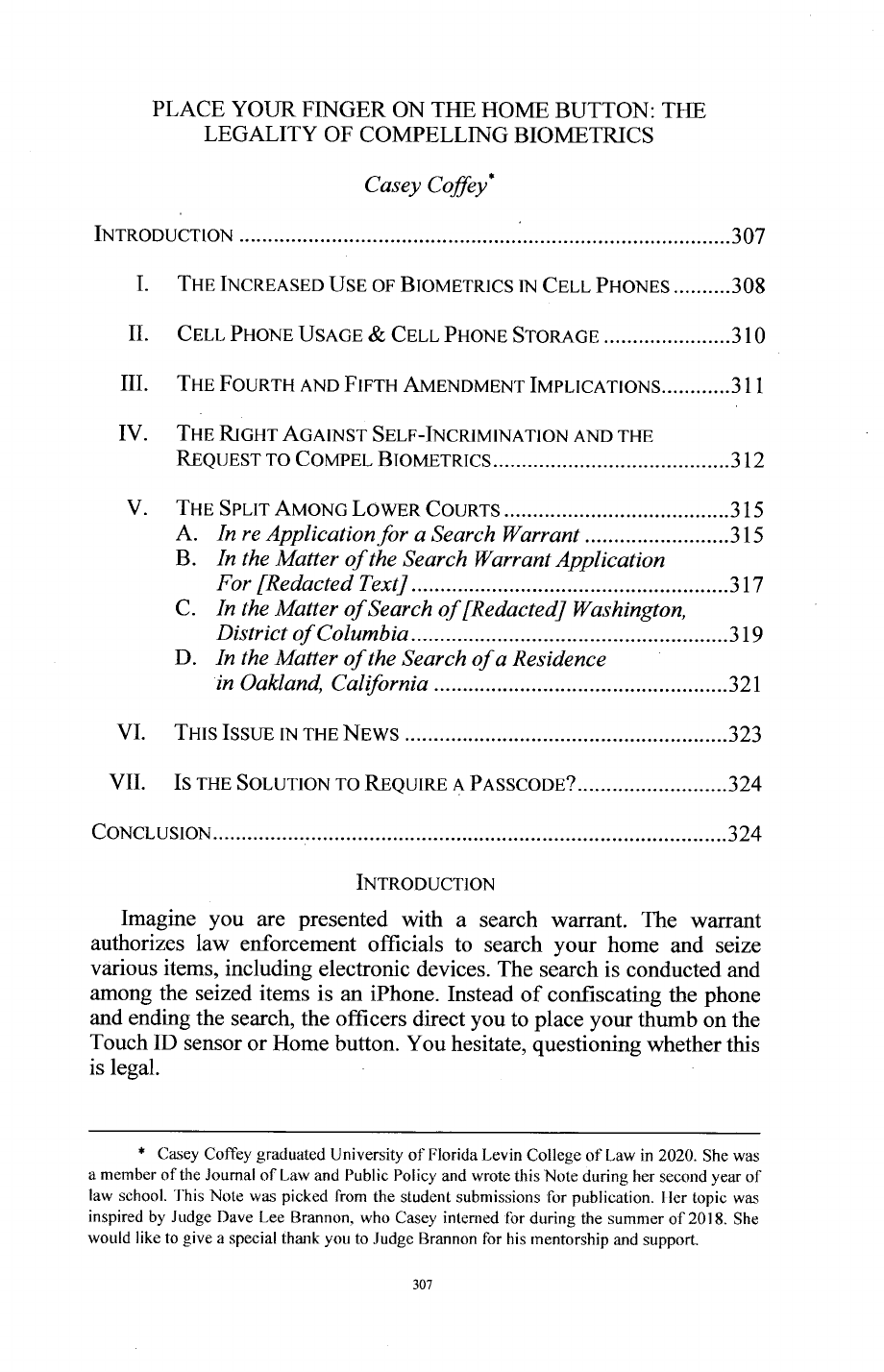
PLACE
YOUR
FINGER
ON
THE
HOME
BUTTON:
THE
LEGALITY
OF
COMPELLING
BIOMETRICS
Casey
Coffey*
INTRODUCTION
.....................................................................................
307
I.
THE
INCREASED
USE
OF
BIOMETRICS
IN
CELL
PHONES
..........
308
II.
CELL
PHONE
USAGE
&
CELL
PHONE
STORAGE
......................
310
III.
THE
FOURTH
AND
FIFTH
AMENDMENT
IMPLICATIONS............311
IV.
THE RIGHT
AGAINST
SELF-INCRIMINATION
AND
THE
REQUEST
TO
COMPEL
BIOMETRICS.........................................312
V.
THE
SPLIT
AMONG
LOWER
COURTS
.......................................
315
A.
In
re Application
for
a
Search
Warrant
.........................
315
B.
In
the
Matter
of
the
Search
Warrant
Application
For
[Redacted
Text]
.......................................................
317
C.
In
the
Matter
of
Search
of
[Redacted]
Washington,
District
of
Columbia.......................................................319
D.
In
the
Matter
of
the
Search
of
a
Residence
in Oakland,
California
...................................................
321
VI.
THIS
ISSUE
IN
THE
N
EWS
........................................................
323
VII.
IS
THE
SOLUTION
TO
REQUIRE
A
PASSCODE?..............
.
. . . . . . . . . . .
324
CONCLUSION.........................................................................................324
INTRODUCTION
Imagine
you
are
presented
with
a
search
warrant.
The
warrant
authorizes
law
enforcement
officials
to
search
your
home
and
seize
various
items,
including
electronic
devices.
The
search
is
conducted
and
among
the
seized
items
is
an
iPhone.
Instead
of
confiscating
the
phone
and
ending
the
search,
the officers
direct
you
to
place
your
thumb
on the
Touch
ID
sensor
or
Home
button.
You
hesitate,
questioning
whether
this
is legal.
*
Casey
Coffey
graduated
University
of
Florida
Levin
College
of
Law
in
2020.
She
was
a
member
of
the
Journal
of
Law
and
Public
Policy
and
wrote
this
Note
during
her
second
year
of
law
school.
This
Note
was
picked
from
the
student
submissions
for
publication.
Ier
topic
was
inspired
by
Judge
Dave
Lee
Brannon,
who
Casey
interned
for
during
the
summer
of
2018.
She
would
like
to
give
a
special
thank
you
to
Judge
Brannon
for
his
mentorship
and
support.
307
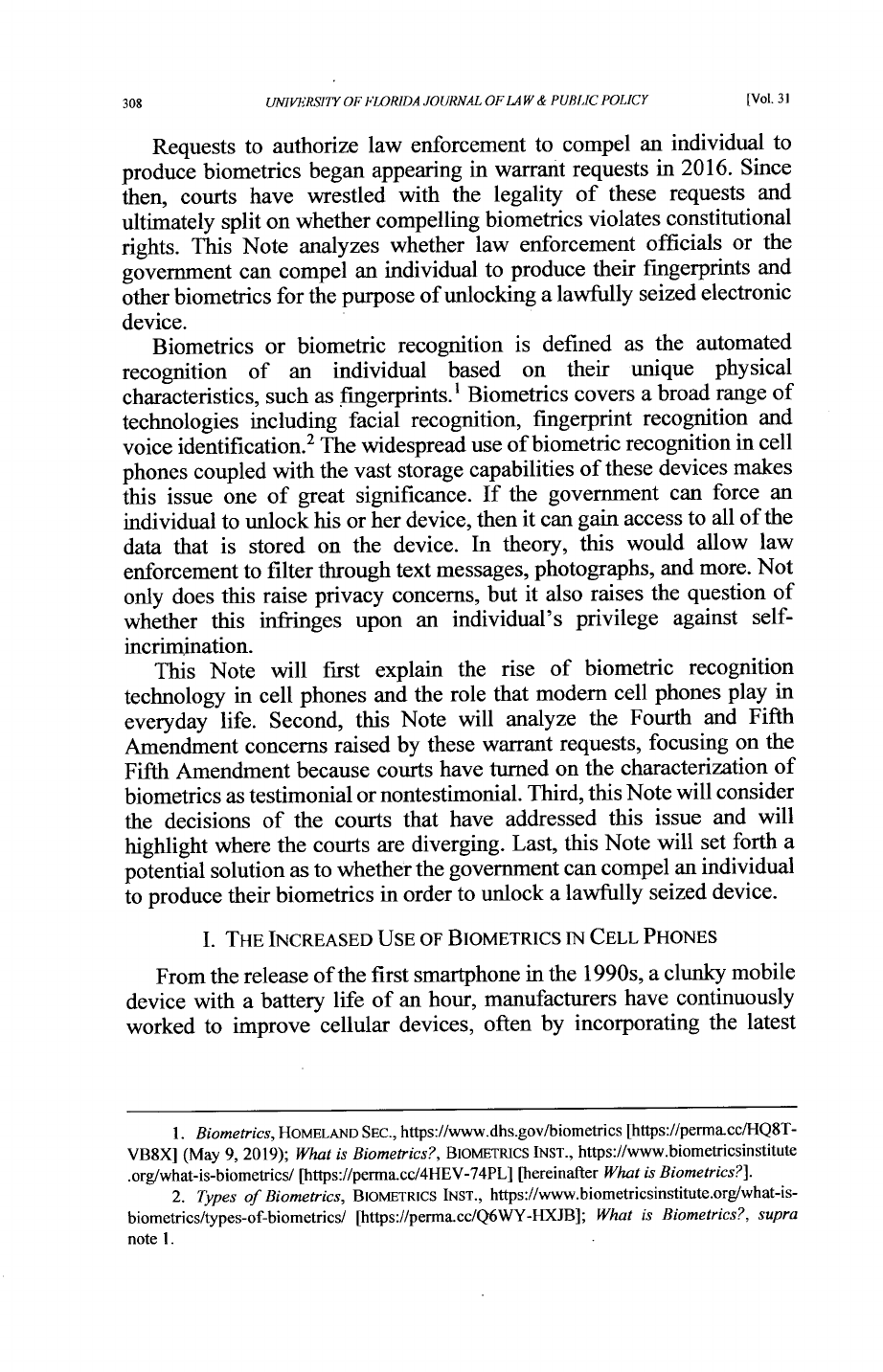
308
UMVERSITY
OF
FLORIDA
JOURNAL
OF
LAW
&
PUBLIC
POLICY
[Vol.
31
Requests
to
authorize
law
enforcement
to
compel
an
individual
to
produce
biometrics
began
appearing
in
warrant
requests
in
2016.
Since
then,
courts
have
wrestled
with
the
legality
of
these
requests
and
ultimately
split
on
whether
compelling
biometrics
violates
constitutional
rights.
This
Note
analyzes
whether
law
enforcement
officials
or
the
government
can
compel
an
individual
to
produce
their
fingerprints
and
other
biometrics
for
the
purpose
of
unlocking
a
lawfully
seized
electronic
device.
Biometrics
or
biometric
recognition
is
defined
as
the
automated
recognition
of
an
individual
based
on
their
unique
physical
characteristics,
such
as
fingerprints.1
Biometrics
covers
a
broad
range
of
technologies
including
facial
recognition,
fingerprint
recognition
and
voice
identification.
2
The
widespread
use
of
biometric
recognition
in
cell
phones
coupled
with
the
vast
storage
capabilities
of
these
devices
makes
this
issue
one
of
great
significance.
If
the
government
can
force
an
individual
to
unlock
his
or
her
device,
then
it
can
gain
access
to
all
of
the
data
that
is
stored
on
the
device.
In
theory,
this
would
allow
law
enforcement
to
filter
through
text
messages,
photographs,
and
more.
Not
only
does
this
raise
privacy
concerns,
but
it
also
raises
the
question
of
whether
this
infringes
upon
an
individual's
privilege
against
self-
incrimination.
This
Note
will
first
explain
the
rise
of
biometric
recognition
technology
in
cell
phones
and
the
role
that
modern
cell
phones
play
in
everyday
life.
Second,
this
Note
will
analyze
the
Fourth
and
Fifth
Amendment
concerns
raised
by
these
warrant
requests,
focusing
on
the
Fifth
Amendment
because
courts
have
turned
on
the
characterization
of
biometrics
as
testimonial
or
nontestimonial.
Third,
this
Note
will
consider
the
decisions
of
the
courts
that
have
addressed
this
issue
and
will
highlight
where
the
courts
are
diverging.
Last,
this
Note
will
set
forth
a
potential
solution
as
to
whether
the
government
can
compel
an
individual
to
produce
their
biometrics
in
order
to
unlock
a
lawfully
seized
device.
I.
THE
INCREASED
USE
OF
BIOMETRICS
IN
CELL
PHONES
From
the
release
of
the
first
smartphone
in
the
1990s,
a
clunky
mobile
device
with
a
battery
life
of
an
hour,
manufacturers
have
continuously
worked
to
improve
cellular
devices,
often
by
incorporating
the
latest
1.
Biometrics,
HOMELAND
SEC.,
https://www.dhs.gov/biometrics
[https://perma.cc/HQ8T-
VB8X]
(May
9,
2019);
What
is
Biometrics?,
BIOMETRICS
INST.,
https://www.biometricsinstitute
.org/what-is-biometrics/
[https://perma.cc/4HEV-74PL]
[hereinafter
What
is
Biometrics?].
2.
Types
of
Biometrics,
BIOMETRICS
INST.,
https://www.biometricsinstitute.org/what-is-
biometrics/types-of-biometrics/
[https://perma.cc/Q6WY-HXJB];
What
is
Biometrics?,
supra
note
1.

THE
LEGALITYOFCOMPELLING
BIOMETRICS
technology.
3
In
2013,
Apple
introduced
the
first
major
smartphone
to
utilize
biometrics,
the
iPhone
5s.4
The
iPhone
5s
features
a
fingerprint
sensor
named
Touch
ID.
5
Touch
ID
allows
users
to
register
a
fingerprint
that
they
can
then
use
to
unlock
the
device.
6
In
most
circumstances,
this
allows
users
to
secure
their
cell
phones
without
requiring
a
passcode.
With
Touch
ID,
you
are
able
to
unlock
your
device
with
just
a
touch.
Other
cell
phone
manufacturers,
such
as
Samsung,
followed
suit
and
incorporated
biometric
recognition
into
their products.
7
Less
than
four
years
after
the
release
of
Touch
ID,
Apple
revealed
the
iPhone
X.
The
iPhone
X
contained
the
latest
of
biometric
technology,
Face
ID.
8
Face
ID
involves
the use
of
facial
recognition
software.
9
Face
ID's
advanced
technology
maps
the
geometry
of
an
individual's
face
and
then
allows
the
individual
to
unlock
the
device
with
a
glance
at
the
front
camera.
10
Face
ID
is
ble
to
register
when
a
user
wants
to
unlock
their
device
and adapts
to
changes
in appearance.
1
'
Apple
claims
that
Touch
ID
and
Face
ID
utilize
"some
of
[Apple's]
most
sophisticated
technologies"
to
ensure
that
customers'
devices
are
protected
from
the
security
risks
that
accompany
this
technology,
such
as
false
matches
and
fraud.1
2
One
protective
measure
for
users
utilizing
Touch
ID
or
Face
ID
is
that
the
phone
is
set
up
with
a
passcode.1
3
The
passcode
must
be
entered
in
order
to
unlock
the
device
under
certain
circumstances
such
as
when
the
device
hasn't
been
unlocked
for
more
than
48
hours
or
when
the
device
restarts.1
4
It
is
also
required
when
there
3.
Doug
Aamoth,
First
Smartphone
Turns
20:
Fun
Facts
About
Simon,
TIME
(Aug.
18,
2014),
http://time.com/3137005/first-smartphone-ibm-simon/
[https://perma.cc/ZGJ2-LQVC]
("A
tip
of
the
hat
to
Simon,
long
referenced
as
the
first
smartphone.
It
went
on
sale
to
the
public
on
August
16,
1994.").
4.
Fionna
Agomuoh,
Password-free
smartphones
are
no
longer
the
stuff
ofscience
fiction
-
they're
everywhere,
Bus.
INS[DER
(Dec.
27,
2017,
3:28 PM),
https://www.businessinsider.com/
smartphone-biometrics-are-no-longer-the-stuff-of-science-fiction-2017-12
[https://perma.cc/7Y
JE-B8RG].
5.
Id.
6.
Use
Touch
ID
on
iPhone
and
iPad,
APPLE
(Apr.
24,
2019), https:Hsupport.apple
.com/en-us/HT201371
[https://perma.cc/6GKJ-MGKR].
7.
Agomuoh,
supra
note
4.
8.
Brian
Roemmele,
How
Does
Apple's
New
Face
ID
Technology
Work?,
FoRBES
(Sept.
13,
2017,
12:47
PM),
https://www.forbes.com/sites/quora/2017/09/13/how-does-apples-new-
face-id-technology-work/#1c4e636f2b7f
[https://perma
cc/8PWN-MMQG].
9.
Id.
10.
Face
ID
Security
Guide,
APPLE,
2
(Nov.
2017),
https://www.apple.com/tr/business/
docs/site/FacelDSecurityGuide.pdf
[https://perma.cc/V86R-4N3F]
[hereinafter
Face
ID
Security
Guide].
11.
Id.
12.
About
Touch
ID
Advanced
Security
Technology,
APPLE
(Sept.
11,
2017),
https://support.apple.com/en-us/HT204587
[https://perma.cc/GGQ3-WUP2].
13.
Face
ID
Security
Guide,
supra
note
10.
14.
Id.
2021]1
309
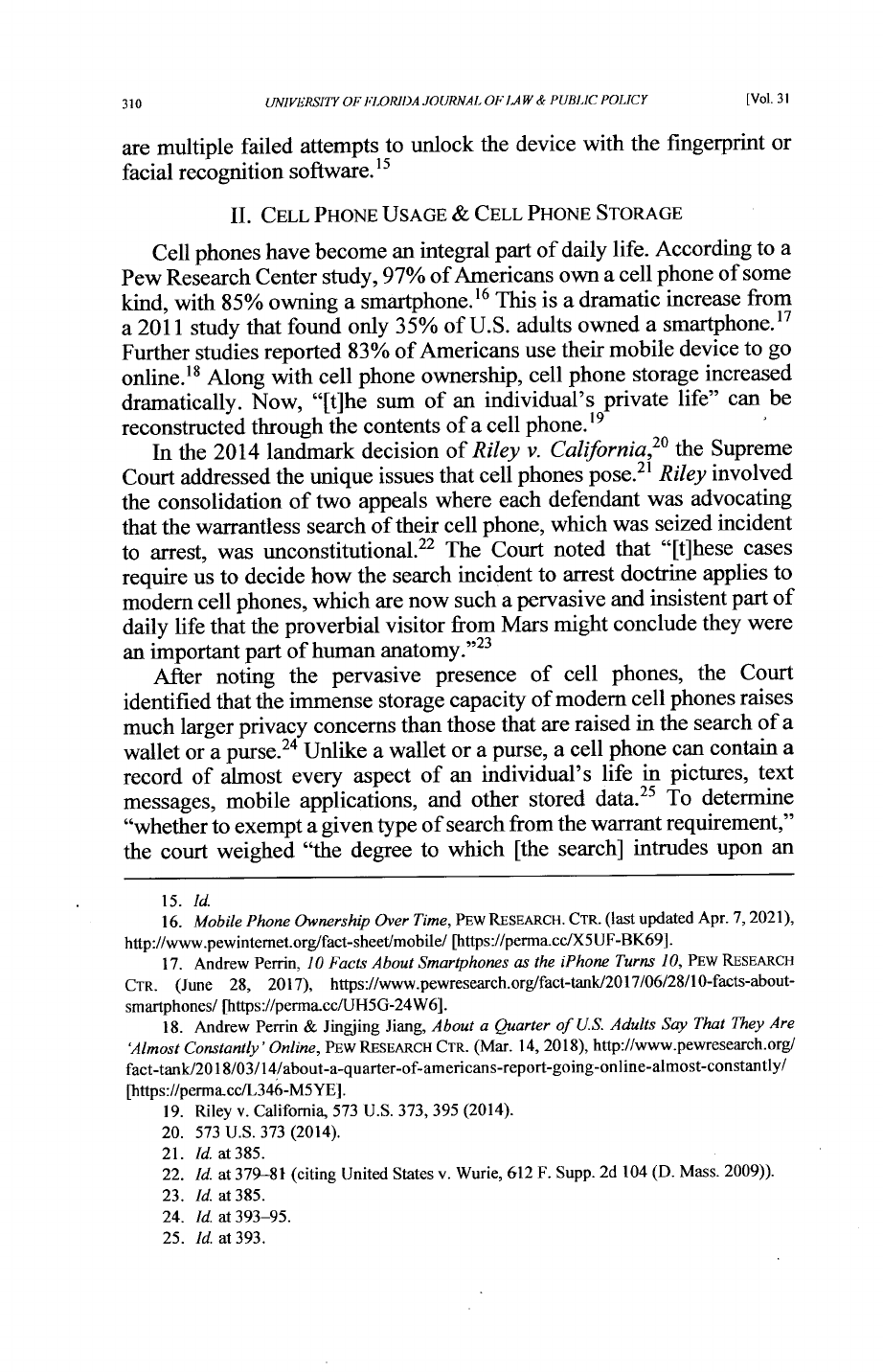
UNIVERSITY
OF
FLORJDA
JOURNAL
OF
LAW
&
PUBLIC
POLICY
are
multiple
failed
attempts
to
unlock
the
device
with
the
fingerprint
or
facial
recognition
software.'
5
II.
CELL
PHONE
USAGE
&
CELL
PHONE
STORAGE
Cell
phones
have
become
an
integral
part
of
daily
life.
According
to a
Pew
Research
Center
study,
97%
of
Americans
own
a cell
phone
of
some
kind,
with
85%
owning
a
smartphone.1
6
This
is
a
dramatic
increase
from
a
2011
study
that
found
only
35%
of
U.S.
adults
owned
a
smartphone.1
7
Further
studies
reported
83%
of
Americans
use
their
mobile
device
to
go
online.
8
Along
with
cell
phone
ownership,
cell
phone
storage
increased
dramatically.
Now,
"[t]he
sum
of
an
individual's
private
life"
can
be
reconstructed
through
the
contents
of
a
cell
phone.19
In
the
2014
landmark
decision
of
Riley
v.
California,
2 0
the
Supreme
Court
addressed
the
unique
issues
that
cell
phones
pose.
21
Riley
involved
the
consolidation
of
two
appeals
where
each
defendant
was
advocating
that
the
warrantless
search
of
their
cell
phone,
which
was
seized
incident
to
arrest,
was
unconstitutional.
22
The
Court
noted
that
"[t]hese
cases
require
us
to
decide
how
the
search
incident
to
arrest
doctrine
applies
to
modern
cell
phones,
which
are
now
such
a
pervasive
and
insistent
part
of
daily
life
that
the
proverbial
visitor
from
Mars
might
conclude
they
were
an
important
part
of
human
anatomy."
2
3
After
noting
the
pervasive
presence
of
cell
phones,
the
Court
identified
that
the
immense
storage
capacity
of
modern
cell
phones
raises
much
larger
privacy
concerns
than
those
that
are
raised
in
the
search
of
a
wallet
or
a
purse.
2
4
Unlike
a
wallet
or
a purse,
a
cell
phone
can
contain
a
record
of
almost
every
aspect
of
an
individual's
life
in
pictures,
text
messages,
mobile
applications,
and
other
stored
data.
25
To
determine
"whether
to
exempt
a
given
type
of
search
from
the
warrant
requirement,"
the
court
weighed
"the
degree
to
which
[the
search]
intrudes
upon
an
15.
Id.
16.
Mobile
Phone
Ownership
Over
Time,
PEW
RESEARCH.
CTR.
(last
updated
Apr.
7,
2021),
http://www.pewinternet.org/fact-sheet/mobile/
[https://perma.cc/X5UF-BK69].
17.
Andrew
Perrin,
10
Facts
About
Smartphones
as
the
iPhone
Turns
10,
PEW
RESEARCH
CTR.
(June
28,
2017),
https://www.pewresearch.org/fact-tank/2017/06/
2 8
/10-facts-about-
smartphones/
[https://perma.cc/UH5G-24W6].
18.
Andrew
Perrin
&
Jingling
Jiang,
About
a
Quarter
of
U.S.
Adults
Say
That
They
Are
'Almost
Constantly'
Online,
PEw
RESEARCH
CTR.
(Mar.
14,
2018),
http://www.pewresearch.org/
fact-tank/2018/03/14/about-a-quarter-of-americans-report-going-online-almost-constantly/
[https://perma.cc/L346-M5YE].
19.
Riley
v.
California,
573
U.S.
373,
395
(2014).
20.
573
U.S.
373
(2014).
21.
Id.
at
385.
22.
Id.
at
379-81
(citing
United
States
v.
Wurie,
612
F.
Supp.
2d 104
(D.
Mass.
2009)).
23.
Id.
at
385.
24.
Id.
at
393-95.
25.
Id.
at 393.
[Vol.
31
310
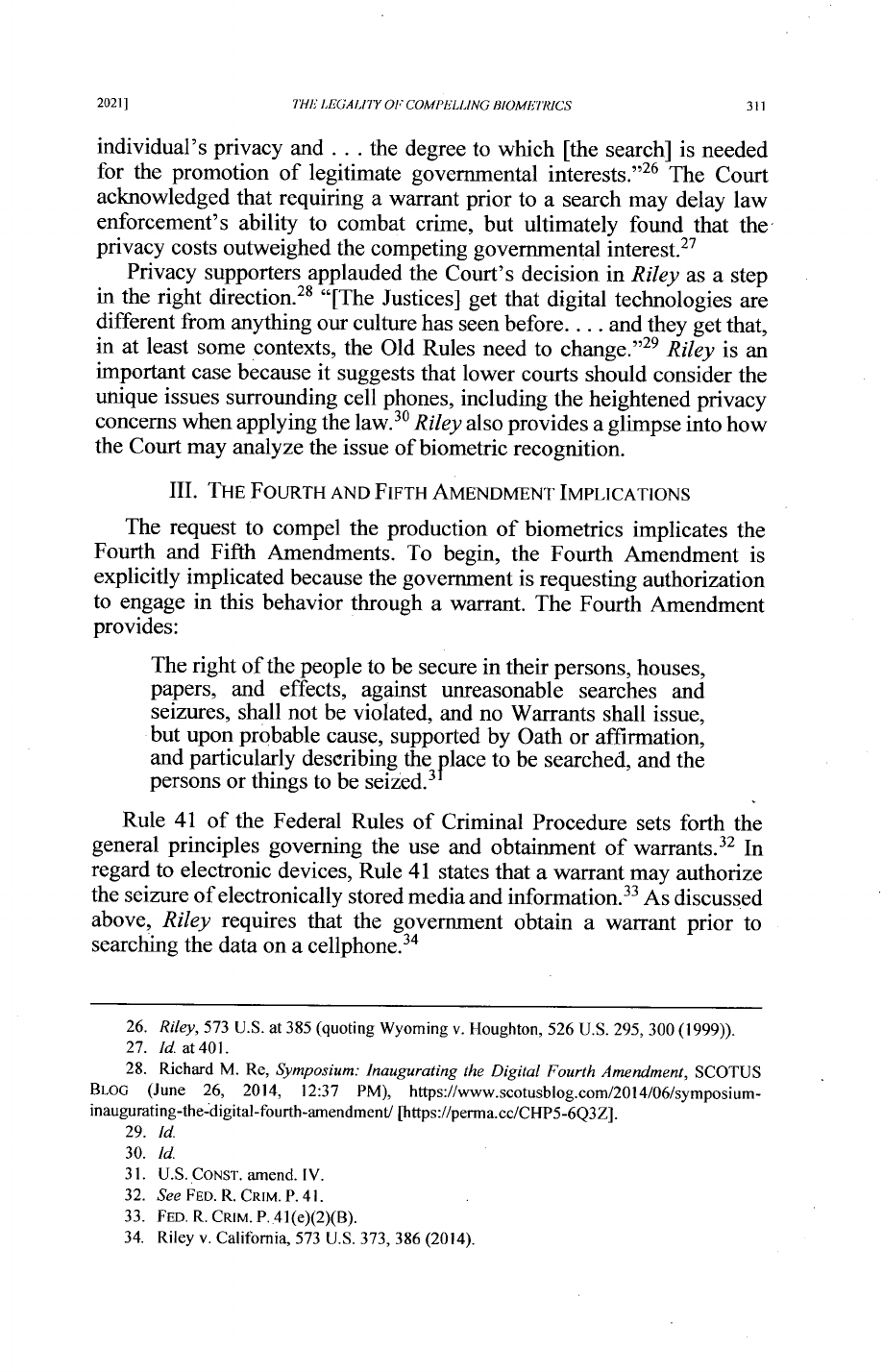
THE
LEGALiTY
OF
COMPELLING
13IOMETIRiCS
individual's
privacy
and
.
. .
the
degree
to
which
[the
search]
is
needed
for
the
promotion
of
legitimate
governmental
interests."
2
6
The
Court
acknowledged
that
requiring
a
warrant
prior
to
a
search
may
delay
law
enforcement's
ability
to
combat
crime,
but
ultimately
found
that
the
privacy
costs
outweighed
the
competing
governmental
interest.
2
7
Privacy
supporters
applauded
the
Court's
decision
in
Riley
as
a
step
in
the
right
direction.
28
"[The
Justices]
get
that
digital
technologies
are
different
from
anything
our
culture
has
seen
before..
. .
and
they
get
that,
in
at
least
some
contexts,
the
Old
Rules
need
to
change."
29
Riley
is
an
important
case
because
it
suggests
that
lower
courts
should
consider
the
unique
issues
surrounding
cell
phones,
including
the
heightened
privacy
concerns
when
applying
the
law.
3
0
Riley
also
provides
a
glimpse
into
how
the
Court
may
analyze
the
issue
of
biometric
recognition.
III.
THE
FOURTH
AND
FIFTH
AMENDMENT
IMPLICATIONS
The
request
to
compel
the
production
of
biometrics
implicates
the
Fourth
and
Fifth
Amendments.
To
begin,
the
Fourth
Amendment
is
explicitly
implicated
because
the
government
is
requesting
authorization
to
engage
in
this
behavior
through
a
warrant.
The
Fourth
Amendment
provides:
The
right
of
the
people
to
be
secure
in
their
persons,
houses,
papers,
and
effects,
against
unreasonable
searches
and
seizures,
shall
not
be
violated,
and
no
Warrants
shall
issue,
but
upon
probable
cause,
supported
by
Oath
or
affirmation,
and
particularly
describing
the
place
to
be
searched,
and
the
persons
or
things
to
be
seized.
3
'
Rule
41
of
the
Federal
Rules
of
Criminal
Procedure
sets
forth
the
general
principles
governing
the
use
and
obtainment
of
warrants.
3
2
In
regard
to
electronic
devices,
Rule
41
states
that
a
warrant
may
authorize
the
seizure
of
electronically
stored
media
and
information.
33
As
discussed
above,
Riley
requires
that
the
government
obtain
a
warrant
prior
to
searching
the
data
on
a cellphone.
34
26.
Riley,
573
U.S.
at
385
(quoting
Wyoming
v.
Houghton,
526
U.S.
295,
300
(1999)).
27.
Id.
at
401.
28.
Richard
M.
Re,
Symposium:
Inaugurating
the
Digital
Fourth
Amendment,
SCOTUS
BLOG
(June
26,
2014,
12:37
PM),
https://www.scotusblog.com/2014/06/symposium-
inaugurating-the-digital-fourth-amendment/
[https://perma.cc/CHP5-6Q3Z].
29.
Id.
30.
Id.
31.
U.S.
CONST.
amend.
IV.
32.
See
FED.
R.
CRIM.
P.
41.
33.
FED.
R.
CRIM.
P.
41(e)(2)(B).
34.
Riley
v.
California,
573
U.S.
373,
386
(2014).
2021]
311

UNIVERSITY
OF
FLORIDA
JOURNAL
OF
LAW
&
PUBLIC
POLICY
Moreover,
the
Fourth
Amendment
is
implicated
because
of
an
individual's
right
to
privacy.
Case
law
has
established
that
the
basic
purpose
behind
the
Fourth
Amendment
"is
to
safeguard
the
privacy
and
security
of
individuals
against
arbitrary
invasions
by
governmental
officials."
35
Like
the
Court
recognized
in
Riley,
privacy
concerns
are
at
an
all-time
high
when
cell
phones
are
involved
since
an
individual's
entire
private
life
can
be
reconstructed
through
the
stored
information.
36
The
Court
reaffirmed
the
interest
in
safeguarding
privacy
rights
of
individuals
in
Carpenter
v.
United
States.
3
7
There,
the
Court
restated
that
even
in
the
face
of
advancing
technology,
"this
Court
has
sought
to
'assure
preservation
of
that
degree
of
privacy
against
government
that
existed
when
the
Fourth
Amendment
was
adopted.'
3
8
In
Carpenter,
the
Court
applied
the
Fourth
Amendment
"to
a
new
phenomenon:
the
ability
to
chronicle
a
erson's
past
movements
through
the
record
of
his
cell
phone
signals."3
While
the
holding
in
Carpenter
was
stressed
to
be
a
narrow
one,
the
Court
nevertheless
recognized
an
individual's
reasonable
privacy
expectation
"in
the
whole
of
their
physical
movements"
and
found
that
the
government
did
not
acquire
the
required
warrant
before
seizing
the
defendant's
cell-site
records.
4
0
Despite
the
fact
that
there
are
various
Fourth
Amendment
concerns
raised
by
these
warrant
requests,
the
courts
that
have
addressed
this
issue
have
dedicated
little
space
to
the
Fourth
Amendment
analysis
and
focused
on
the
constitutionality
of
these
requests
under
the
Fifth
Amendment.
While
the
courts'
decisions
seem
to
turn
on
whether
or
not
the
compelled
production
of
a
physical
characteristic
is
testimonial
or
nontestimonial
under
the
Fifth
Amendment,
the
Fourth
Amendment
is
likely
to
play
a
much
larger
role
in
the
outcome
of
this
issue
as
it
works
its
way
up
the
courts.
This
is
supported
by
the
Court's
recent
analyses
in
Carpenter
and
Riley,
where
the
Court
stressed
the
heightened
privacy
concerns
due
to
the
advancement
of
technology.
IV.
THE
RIGHT
AGAINST
SELF-INCRIMINATION
AND
THE
REQUEST
TO
COMPEL
BIOMETRICS
The
Fifth
Amendment
provides
in
relevant
part:
"No
person
..
.
shall
be
compelled
in
any
criminal
case
to
be
a
witness
against
himself
....
"4
It
is
well
established
that
the
right
against
self-incrimination
is
not
35.
Carpenter
v.
United
States,
138
S.
Ct.
2206,
2213
(2018)
(quoting
Camara
v.
Mun.
Ct.
of
City
and
Cnty.
of
S.F.,
387 U.S.
523,
528
(1967)).
36.
See
Riley,
573
U.S.
at
386.
37.
Carpenter,
138
S.
Ct.
at
2214.
38.
Id.
(quoting
Kyllo
v.
United
States,
533
U.S.
27,
34
(2001)).
39.
Id.
at
2216.
40.
Id.
at
2217,
2220.
41.
U.S.
CONST.
amend.
V.
[Vol.
31
312

THE
LEGALI7
OF
COMPELLING
BIOMETRICS
absolute.
4
2
The
privilege
only
applies
to
communications
that
are
testimonial,
compelled,
and
incriminating.
43
It
is
a
relatively
simple
task
to
determine
whether
a
communication
is
compelled
or
is
incriminating,
but
the
line
becomes
blurry
when
deciding
what
constitutes
a
testimonial
versus
a
nontestimonial
communication.
To
this
end,
the
Court
has
stated
that
"[t]he
difficult
question
whether
a
compelled
communication
is
testimonial
for
purposes
of
applying
the
Fifth
Amendment
often
depends
on the
facts
and
circumstances
of
the
particular
case."
44
A
testimonial
communication
is
a
communication
that
"explicitly
or
implicitly,
relate[s]
a
factual
assertion
or disclose[s]
information."
4
5
The
Court
has
consistently
held
that
the
compulsion
of
certain
acts falls
outside
the
protections
of
the
Fifth
Amendment
despite
the
fact
that
the
compelled
act
may
lead
to
incriminating
information.
46
For
example,
in
Schmerber
v.
California,
4
7
the Court
held
that
the
forced
taking
of
a
blood
sample
did not
violate
the
individual's
right
against
self-incrimination.
48
The
Court
recognized
that
in
compelling
the
blood
sample
the
accused
was
forced
"to
submit
to
an
attempt
to
discover
evidence
that might
be
used
to
prosecute
him
for a criminal
offense,"
but
this
was
not
enough
to
bring
the
compelled
act
within
the
meaning
of
the
privilege.
49
"Not
even
a
shadow
of
testimonial
compulsion
upon
or enforced
communication
by
the
accused
was
involved
either
in
the
extraction
or
in
the
chemical
analysis."
5 0
Similarly,
the
compulsion
of
voice exemplars,
handwriting
exemplars,
and
fingerprints
all fall
outside
the
Fifth
Amendment
privilege.
5
'
Through
this
line
of
cases,
the
Court
generally
established
42.
United
States
v.
Hubbell,
530
U.S.
27,
34
(2000)
("The term
'privilege
against
self-
incrimination'
is
not
an
entirely
accurate
description
of
a
person's
constitutional
protection
against
being
'compelled
in
any
criminal
case
to
be
a
witness
against
himself.'
The
word
'witness'
in
the
constitutional
text
limits
the
relevant
category
of
compelled
incriminating
communications
to
those that
are
'testimonial'
in
character.").
43.
Id.
44.
Doe
v.
United
States,
487
U.S.
201,
214-15
(1988)
(citing
Fisher
v.
United
States,
425
U.S.
391,
410
(1976)).
45.
Id
at
210.
46.
Id.
47.
384
U.S.
757
(1966).
48.
Id.
at
772.
49.
Id.
at
761.
50.
Id.
at
765.
51.
See
United
States
v.
Dionisio,
410
U.S.
1,
5-7
(1973)
(compelling
voice
exemplars
does
not violate
the
Fifth
Amendment);
Gilbert
v.
California,
388
U.S.
263,
265-67
(1967)
(compelling
handwriting
exemplars
does
not
violate
the
Fifth
Amendment);
Holt
v.
United
States,
218
U.S.
245,
252-53
(1910)
(compelling
a
suspect
to
put
on
particular
clothing
does
not
violate
the Fifth
Amendment);
Schmerber,
384
U.S.
at
764
(compelling
a
suspect
to
submit
to
fingerprinting
does
not
violate
the
Fifth
Amendment).
20211
313

UNIVERSITY
OF
FLORIDA
JOURNAL
OF
LAW
&
PUBLIC
POLICY
that
there
is
no
testimonial
communication
in
the
"compelled
display
of
identifiable
physical
characteristics."
52
The
compelled
production
of
specific
documents
also
raises
Fifth
Amendment
concerns.
53
In
Fisher
v.
United
States,
54
the
compelled
production
of
documents
was
held
non-testimonial
because
the
papers
were
voluntarily
prepared
prior
to
the
summons.
55
Based
on
this,
the
individual
could
not
avoid
complying
with
the
summons
on
the
grounds
that
the
documents
contained
incriminating
information.
5
6
However,
in
United
States
v.
Hubbell,
57
the
respondent
was
similarly
subpoenaed
to
produce
specific
documents,
but
the
Court
held
this
to
be
a
testimonial
communication.
58
In
analyzing
the
compelled
act
the
Court
stated:
We
have
held
that
"the
act
of
production"
itself
may
implicitly
communicate
"statements
of
fact."
By
"producing
documents
in
compliance
with
a
subpoena,
the
witness
would
admit
that
the
papers
existed,
were
in
his
possession
or
control,
and
were
authentic."
.
.
.
Whether
the
constitutional
privilege
protects
.
.
.
the
act
of
production
itself,
is
a
question
that
is
distinct
from
the
question
whether
the
unprotected
contents
of
the
documents
themselves
are
incriminating.
5
9
Here,
the
Court
found
that
the
respondent
would
"make
extensive
use
of
'the
contents
of
his
own
mind"'
in
identifying
and
assembling
the
compelled
documents.
6
0
This
made
the
production
more
analogous
to
"telling
an
inquisitor
the
combination
to
a
wall
safe"
rather
than
"being
forced
to
surrender
the
key
to
a
strongbox."
61
Because
the
defendant
would
implicitly
communicate
statements
of
fact
through
the
production
of
documents,
the
defendant
was
justified
in
refusing
to
comply
with
the
subpoena.
Biometrics
are,
by
definition,
physical
characteristics.
In
warrant
requests
to
compel
biometrics,
law
enforcement
seeks
to
use
these
physical
traits
to
unlock
a
seized
electronic
device.
Law
enforcement
officials
would
likely
argue
that
there
is
no
Fifth
Amendment
issue
when
they
request
authorization
to
compel
the
production
of
biometrics
52.
See
Dionisio,
410
U.S.
at
5-7
(citing
Gilbert,
388
U.S.
at
266-67;
Holt,
218
U.S.
at
252).
53.
See
United
States
v.
Hubbell,
530
U.S.
27,
35-36.
54.
425
U.S.
391
(1976).
55.
Id.
at
414.
56.
Hubbell,
530
U.S.
at
36
(citing
Fisher,
425
U.S.
at
409-10).
57.
530
U.S.
27
(2000).
58.
Id.
at
43.
59.
Id.
at
36-37.
60.
Id.
at
43
(quoting
Curcio
v.
United
States,
354
U.S.
118,
128
(1957)).
61.
Id.
(citing
Doe
v.
United
States,
487
U.S.
201,
210
n.9
(1988)).
[Vol.
31
314
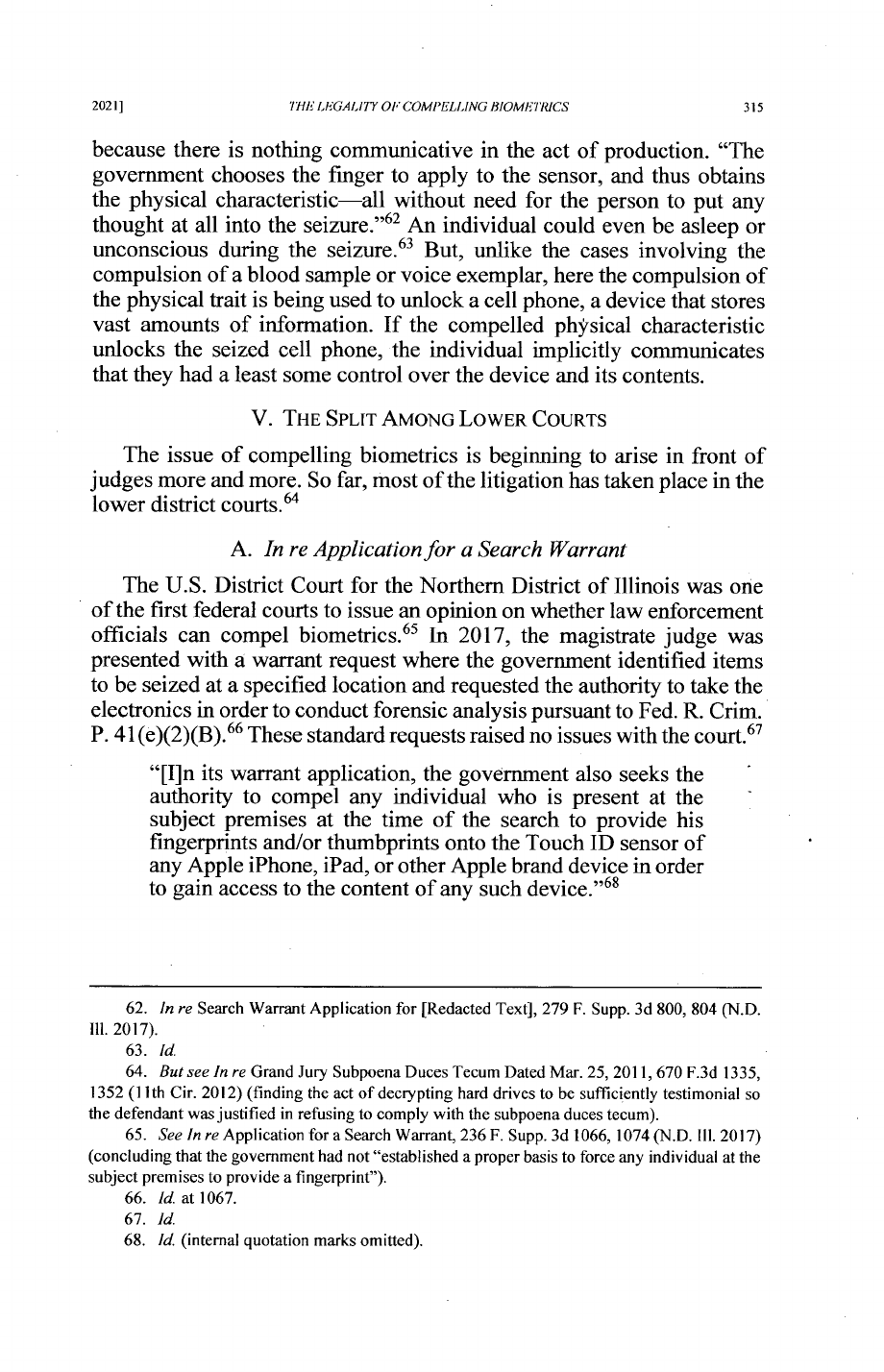
21iE
LEGALITY
OF
COMPELLING
BIOMETRICS
because
there
is
nothing
communicative
in
the
act
of
production.
"The
government
chooses
the
finger
to
apply
to the
sensor,
and
thus
obtains
the
physical
characteristic-all
without
need
for
the
person
to
put
any
thought
at
all
into the
seizure."
62
An
individual
could
even
be
asleep
or
unconscious
during
the
seizure.
63
But,
unlike
the cases
involving
the
compulsion
of
a
blood
sample
or
voice
exemplar,
here the
compulsion
of
the
physical
trait
is
being
used
to
unlock
a
cell
phone,
a device
that
stores
vast
amounts
of
information.
If
the
compelled
physical
characteristic
unlocks
the
seized
cell
phone,
the
individual
implicitly
communicates
that
they
had
a
least some
control
over
the
device
and
its
contents.
V.
THE
SPLIT
AMONG
LOWER
COURTS
The
issue
of
compelling
biometrics
is
beginning
to
arise in
front
of
judges
more
and
more.
So
far,
most
of
the
litigation
has
taken
place
in
the
lower
district
courts.
"
A.
In
re
Application
for
a
Search
Warrant
The
U.S.
District
Court
for
the
Northern
District
of
Illinois
was
one
of
the
first
federal
courts
to
issue
an
opinion
on
whether
law
enforcement
officials
can
compel
biometrics.
65
In
2017,
the
magistrate
judge
was
presented
with
a
warrant
request
where
the
government
identified
items
to
be
seized
at
a
specified
location
and
requested
the
authority
to
take
the
electronics
in
order
to
conduct
forensic analysis
pursuant
to Fed.
R.
Crim.
P.
41(e)(2)(B).
66
These
standard
requests
raised
no
issues
with
the
court.67
"[I]n
its
warrant
application,
the
government
also
seeks
the
authority
to
compel
any
individual
who
is
present
at
the
subject
premises
at
the
time
of
the
search
to
provide
his
fingerprints
and/or
thumbprints
onto
the
Touch
ID sensor
of
any
Apple iPhone,
iPad,
or
other
Apple brand
device in order
to
gain
access
to
the
content
of
any
such
device."
68
62.
In
re
Search
Warrant
Application
for
[Redacted
Text],
279
F.
Supp.
3d
800,
804
(N.D.
111.
2017).
63.
Id.
64.
But
see
In
re
Grand
Jury
Subpoena
Duces
Tecum
Dated
Mar.
25,
2011,
670
F.3d
1335,
1352
(11th
Cir.
2012)
(finding
the
act
of
decrypting
hard
drives
to
be
sufficiently
testimonial
so
the
defendant
was
justified
in
refusing
to
comply
with
the
subpoena
duces
tecum).
65.
See
In
re
Application
for
a
Search
Warrant,
236
F.
Supp.
3d
1066,
1074
(N.D.
III.
2017)
(concluding
that
the
government
had
not
"established
a
proper
basis
to
force any
individual
at
the
subject premises
to
provide
a
fingerprint").
66.
Id
at
1067.
67.
Id
68.
Id.
(internal
quotation
marks omitted).
2021
]
315

UNIVERSI7Y
OF
FLORIDA
JOURNAL
OF
LA
W
&
PUBLIC
POLICY
This
abnormal
request
raised
a
number
of
concerns
and
was
ultimately
denied.
69
First,
the
judge
found
that
the
warrant
did
not
meet
the probable
cause
requirements
of
the
Fourth
Amendment
to
"compel
any
person
who
happens
to
be
at
the
subject
premises
at
the
time
of
the
search
to
give
his
fingerprint
to
unlock
an
unspecified
Apple
electronic
device."
70
The
government
argued
that
the
Fourth
Amendment
is
not
implicated
in
the
taking
of
a
fingerprint,
but
the
court
rejected
this
view.
71
The
judge
stressed
that
it
is
not
the
fingerprint
itself
but
rather
"the
method
of
obtaining
the
print
that
is
at issue."
72
Here,
the
factual
deficiencies
of
the
warrant
such
as
the
failure
to specify
the
persons
and
specific
devices
likely
to
be
found
at the
premises
violated
the
requirements
of
the
Fourth
Amendment.
7 3
Then,
the
judge
turned
to
the
Fifth
Amendment
concerns.
74
The
Court
cited
Hubbell
and
argued
that
a
fingerprint
is
akin
to
a
key
that
opens
a
strongbox
which
involves
no
testimonial
communication
and
therefore
falls
outside
Fifth
Amendment
protections.
75
The
judge
noted
that
generally
the
production
of
physical
characteristics
does
not
raise
Fifth
Amendment
concerns,
7
6
but
Fifth
Amendment
concerns
are
raised
"where
the
production
of
information
is
compelled,
and
the
production
itself
is
deemed
incriminating."
77
Applying
previous
Supreme
Court
decisions,
the
judge
reasoned
that
the
compelled
act
does
"explicitly
or
implicitly
relate
a
factual
assertion
or
disclose
information"
because
"[t]he
connection
between
the
fingerprint
and
Apple's
biometric
security
system,
shows
a
connection
with
the
suspected
contraband."
78
By
using
a
finger
to
unlock
a
phone's
contents,
a
suspect
is
producing
the
contents
on
the
phone.
With
a
touch
of
a
finger,
a
suspect
is
testifying
that
he
or
she
has
accessed
the
phone
before,
at
a
minimum,
to
set
up
the
fingerprint
password
capabilities,
and
that
he
or
she
currently
has some
69.
Id.
70.
Id.
at
1068.
71.
In
re
Application
for
a
Search
Warrant,
236
F.
Supp.
3d
at
1068,
1069
(citing
United
States
v.
Sechrist,
640
F.2d
81,
86
(7th
Cir.
1981)).
72.
Id.
at 1070.
73.
Id.
74.
Id.
75.
Id.
(citing
Commonwealth
v.
Baust,
89
Va.
Cir.
267,
270
(Va.
Cir.
Ct.
2014)).
76.
Id.
at
1070-71
(citing
United
States
v.
Dionisio,
410
U.S.
1,
5-7
(1973);
Gilbert
v.
California,
388
U.S.
263,
265-67
(1967);
United
States
v.
Wade,
388
U.S.
218
(1967);
Schmerber
v.
California,
384
U.S.
263,
267
(1966)).
77.
In
re
Application
for
a
Search
Warrant,
236
F.
Supp.
3d
at
1071
(citing
Fisher
v.
United
States, 425
U.S.
391,
410
(1976)).
78.
Id.
at
1073
(citing
United
States
v.
Doe,
670
F.3d
1335,
1342
(11th
Cir.
2012)).
[V
ol.
31
316
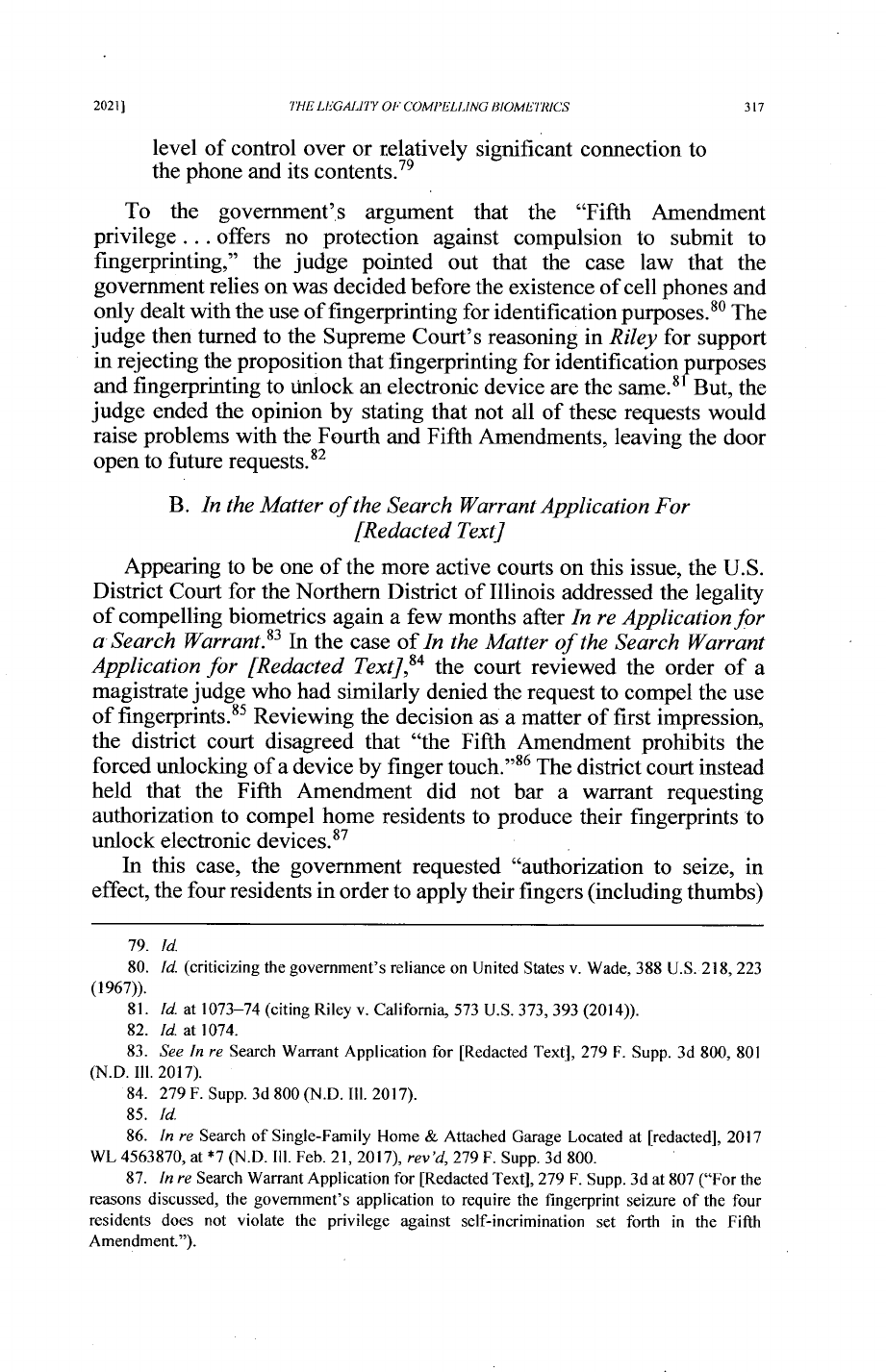
THE
LE'GAIJ7Y
OF
COMPELLING
BIOME7MICS
level
of
control
over
or
relatively
significant
connection
to
the
phone
and
its
contents.
79
To
the
government's
argument
that
the
"Fifth
Amendment
privilege
...
offers
no
protection
against
compulsion
to
submit
to
fingerprinting,"
the
judge
pointed
out
that
the
case
law
that
the
government
relies
on
was
decided
before
the
existence
of
cell
phones
and
only
dealt
with
the
use
of
fingerprinting
for
identification
purposes.
80
The
judge
then
turned
to
the
Supreme
Court's
reasoning
in
Riley
for
support
in
rejecting
the
proposition
that
fingerprinting
for
identification
purposes
and
fingerprinting
to
unlock
an
electronic
device
are
the
same.
81
But,
the
judge
ended
the
opinion
by
stating
that
not
all
of
these
requests
would
raise
problems
with
the
Fourth
and
Fifth
Amendments,
leaving
the
door
open
to
future
requests.
82
B.
In
the
Matter
of
the
Search
Warrant
Application
For
[Redacted
Text]
Appearing
to
be
one
of
the
more
active
courts
on
this
issue,
the
U.S.
District
Court
for
the
Northern
District
of
Illinois
addressed
the
legality
of
compelling
biometrics
again
a
few
months
after
In
re
Application
for
a
Search
Warrant.
83
In
the
case
of
In
the
Matter
of
the
Search
Warrant
Application
for
[Redacted
Text],
84
the
court
reviewed
the
order
of
a
magistrate
judge
who
had
similarly
denied
the
request
to
compel
the
use
of
fmgerprints.
85
Reviewing
the
decision
as
a
matter
of
first
impression,
the
district
court
disagreed
that
"the
Fifth
Amendment
prohibits
the
forced
unlocking
of
a
device
by
finger
touch."
86
The
district
court
instead
held
that
the
Fifth
Amendment
did
not
bar
a
warrant
requesting
authorization
to
compel
home
residents
to
produce
their
fingerprints
to
unlock
electronic
devices.
87
In
this
case,
the
government
requested
"authorization
to
seize,
in
effect,
the
four
residents
in
order
to
apply
their
fingers
(including
thumbs)
79.
Id
80.
Id
(criticizing
the
government's
reliance
on
United States
v.
Wade,
388
U.S.
218,
223
(1967)).
81.
Id
at
1073-74
(citing
Riley
v.
California,
573
U.S. 373,
393
(2014)).
82.
Id
at
1074.
83.
See
In
re
Search
Warrant
Application
for
[Redacted
Text],
279
F.
Supp.
3d 800,
801
(N.D.
II1.
2017).
84.
279
F.
Supp.
3d 800
(N.D.
Ill.
2017).
85.
Id.
86.
In
re
Search
of
Single-Family
Home
&
Attached
Garage
Located
at
[redacted],
2017
WL
4563870,
at
*7
(N.D.
Ill.
Feb. 21,
2017),
rev'd,
279
F.
Supp.
3d
800.
87.
In
re
Search
Warrant
Application
for
[Redacted
Text], 279
F.
Supp.
3d
at
807
("For
the
reasons
discussed,
the
government's
application
to
require
the
fingerprint
seizure
of
the
four
residents
does
not
violate
the
privilege
against
self-incrimination
set
forth
in
the
Fifth
Amendment.").
20211
3\7

318
UN1VERSI7TY
OF
FLORIDA
JOURNAL
OFLA
W
&
PUBLIC
POLICY
[Vol.
31
to
Apple-made
devices
(here,
most
likely
iPhones
and
iPads)
found
at
the
home."
88
The
affidavit
in
support
of
the
warrant
application
stated
that
the
devices
were
likely
encrypted,
requiring
a
passcode
or
Touch
ID.
89
The
government
stressed
that
the
ability
to
unlock
a
device
with
Touch
ID
is
time
sensitive,
"[s]o
to
take
advantage
of
this
potential
way
of
unlocking
an
iPhone
or
iPad,
the
government
asks
that
the
four
residents
of
the
home-if
they
are
present
during
the
search-be
required
to
press
fingers,
chosen
by
the
[G]overnment,
to
the [t]ouch
ID
sensor.
"90
The
magistrate
judge
denied
the
warrant
because
such
a
compelled
production
would
violate
an
individual's
Fifth
Amendment
privilege,
but
the
district
court
reversed
in
part,
finding
that
the
warrant
did
not
violate
an
individual's
right
against
self-incrimination.
91
The
district
court
stated
that
the
fingerprint
seizure
sought
in
the
warrant
application
did
not
engage
the
thought
process
of
any
of
the
individuals.
2
"The
application
of
the
fingerprint
to the
sensor
is
simply
the
seizure
of
a
physical
characteristic,
and
the
fingerprint
by
itself
does
not
communicate
anything."
93
The
district
court
distinguished
this
act
from
the
line
of
cases
that
involve
the
production
of
documents
by
relying
on
the
fact
that
the
compelled
individual
did
not
have
to
put
any
thought
into
the seizure.
94
In
addition,
the
district
court
rejected
the
magistrate
judge's
characterization
of
"the
fingerprint
seizure
as
containing
an
implicit
communication
when
the
fingerprint
is
applied
to
the
Touch
ID
sensor:
if
the
device
unlocks,
then
the
incriminating
inference
is
that
the
person
had
possession
or
control
of
the
device."
9
5
The
court
said
the
fact
that
the
compelled
physical
trait
yields
incriminating
information
does
not
immediately
make
the
compulsion
unconstitutional.
96
"If
a
compelled
act
is
not testimonial,
then
the
privilege
against
self-incrimination
does
not
apply-even
if
the
act
is
incriminating."
97
So,
if
the
act does
not
inherently
contain
a
communication
then
the
compulsion
is
constitutional.
The
court
found
the
surrender
of
a
person's
fingerprint
to
be
analogous
to
the
surrender
of
a
key
to
a
safe
whose
contents
are
otherwise
unavailable.
98
Based
on
this
reasoning,
the warrant
application
did
not
88.
Id.
at
802.
89.
Id.
90.
Id.
91.
Id.
at
801.
92.
Id.
at
804.
93.
In
re
Search
Warrant
Application
for
[Redacted
Text],
279
F.
Supp.
3d
at
807
94.
In
re
Search
Warrant
Application
for
[Redacted
Text],
279
F.
Supp.
3d
at
804.
95.
Id.
at
805
(emphasis
in
original).
96.
Id.
97.
Id.
(citing
Doe
v.
United
States,
487
U.S.
201,
210
(1988)).
98.
Id.
at
806.
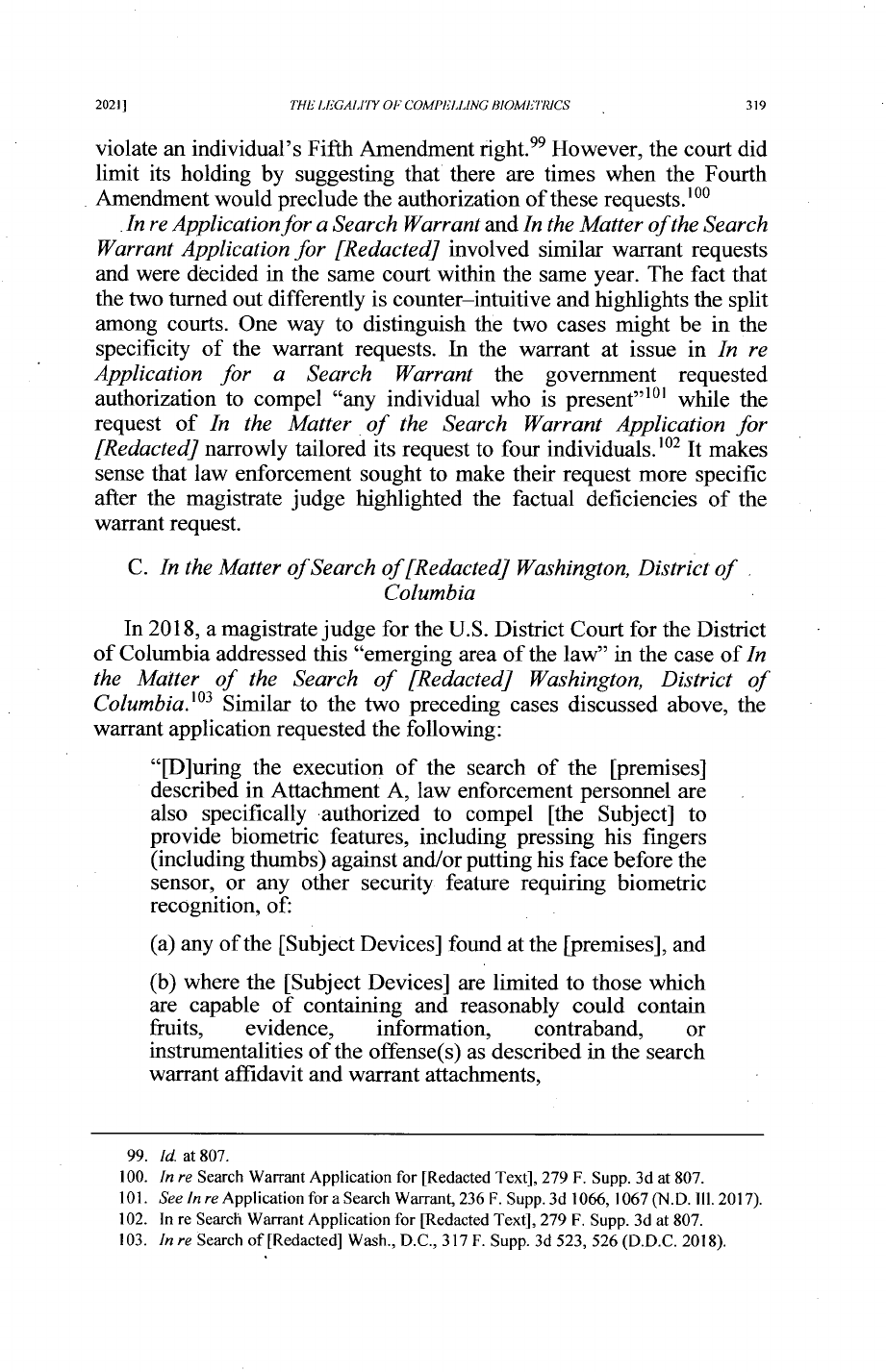
THE
LEGALITY
OF
COMPELLING
BIOMETRICS
violate
an
individual's
Fifth
Amendment
right.
99
However,
the
court
did
limit
its
holding
by
suggesting
that
there
are
times
when
the
Fourth
Amendment
would preclude
the
authorization
of
these
requests.
1
00
In
re
Application
for
a
Search
Warrant
and
In
the
Matter
of
the
Search
Warrant
Application
for
[Redacted]
involved
similar
warrant
requests
and
were
decided
in the
same
court
within
the
same
year.
The
fact
that
the two
turned
out differently
is
counter-intuitive
and
highlights
the
split
among
courts.
One
way
to
distinguish
the two cases
might
be
in
the
specificity
of
the
warrant
requests.
In
the
warrant
at
issue
in
In
re
Application
for
a
Search
Warrant
the
government
requested
authorization
to
compel
"any
individual
who
is
present"
10
'
while
the
request
of
In
the
Matter
of
the
Search
Warrant
Application
for
[Redacted]
narrowly
tailored
its
request
to
four
individuals.
0 2
It
makes
sense
that
law
enforcement
sought
to make
their
request
more
specific
after
the
magistrate
judge
highlighted
the
factual
deficiencies
of
the
warrant
request.
C.
In
the
Matter
of
Search
of
[Redacted]
Washington,
District
of
.
Columbia
In
2018,
a
magistrate
judge
for the
U.S.
District
Court
for
the
District
of
Columbia
addressed
this
"emerging
area
of
the
law"
in the
case
of
In
the
Matter
of
the
Search
of
[Redacted]
Washington,
District
of
Columbia.1
03
Similar
to
the
two
preceding
cases
discussed
above,
the
warrant
application
requested
the following:
"[D]uring
the
execution
of
the
search
of
the
[premises]
described
in Attachment
A,
law
enforcement
personnel
are
also
specifically
authorized
to
compel
[the
Subject]
to
provide
biometric
features,
including
pressing
his
fingers
(including
thumbs)
against
and/or putting
his
face
before
the
sensor,
or
any
other
security
feature
requiring
biometric
recognition,
of:
(a)
any
of
the [Subject
Devices]
found
at
the
[premises],
and
(b)
where
the [Subject
Devices]
are
limited
to those
which
are
capable
of
containing
and
reasonably
could
contain
fruits,
evidence,
information,
contraband,
or
instrumentalities
of
the
offense(s)
as
described
in the
search
warrant
affidavit
and
warrant
attachments,
99.
Id.
at
807.
100.
In
re
Search
Warrant
Application
for
[Redacted
Text], 279
F.
Supp.
3d
at
807.
101.
See
In
re
Application
for
a
Search Warrant,
236
F.
Supp.
3d
1066,
1067
(N.D.
Ill.
2017).
102. In
re
Search
Warrant
Application
for
[Redacted
Text],
279
F.
Supp.
3d
at
807.
103.
In
re
Search
of
[Redacted]
Wash.,
D.C.,
317
F.
Supp.
3d
523, 526
(D.D.C.
2018).
20211
319
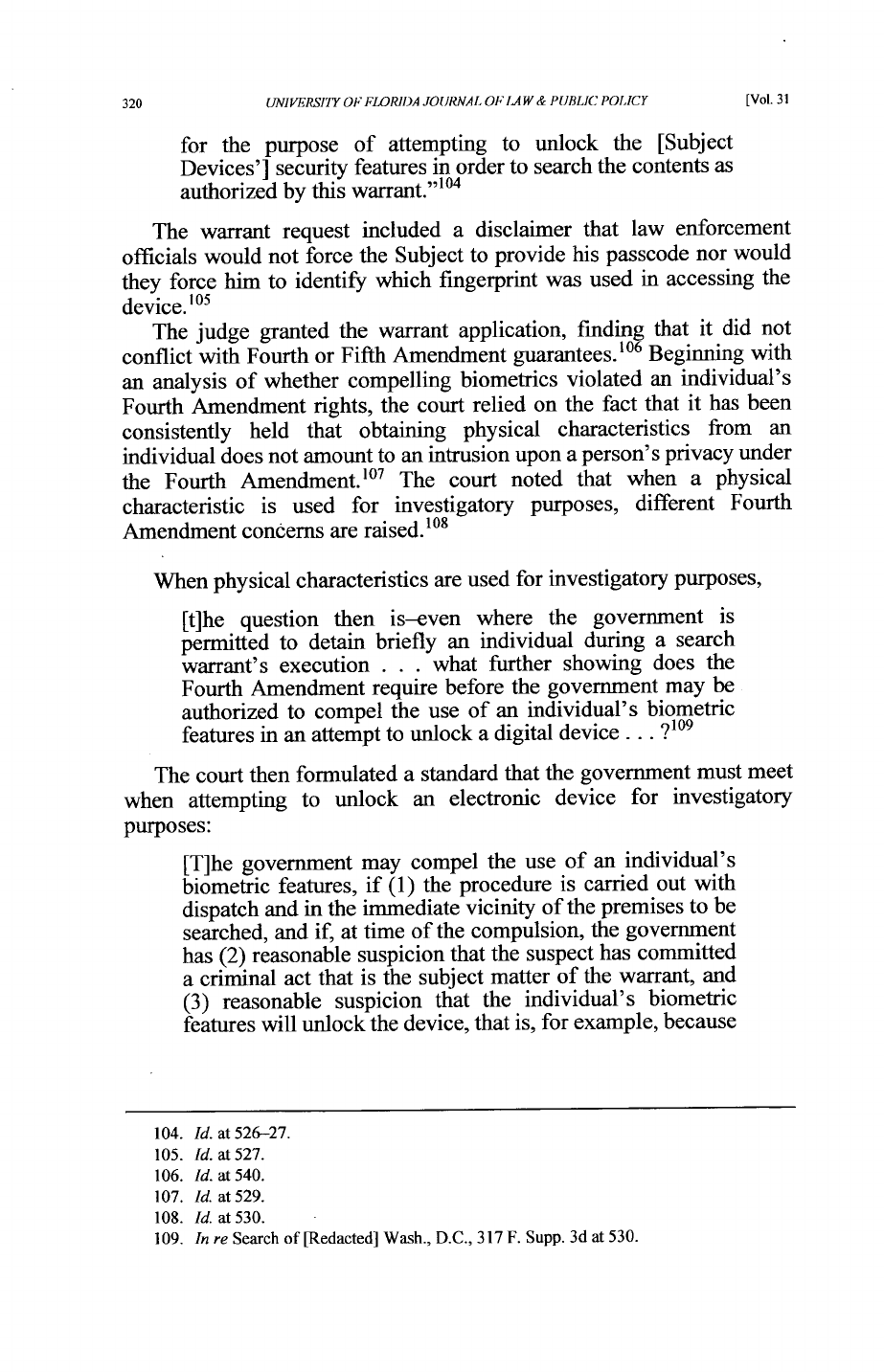
UNIVERSITYOF
FLORIDA
JOURNAL
OF
LAW
&
PUBLIC
POLICY
for
the
purpose
of
attempting
to
unlock
the
[Subject
Devices']
security
features
in
order
to
search
the
contents
as
authorized
by
this
warrant."104
The
warrant
request
included
a
disclaimer
that
law
enforcement
officials
would
not
force
the
Subject
to
provide
his
passcode
nor
would
they
force
him
to
identify
which
fingerprint
was
used
in
accessing
the
device.1
0
5
The
judge
granted
the
warrant
application,
finding
that
it
did
not
conflict
with
Fourth
or
Fifth
Amendment
guarantees.1
0
6
Beginning
with
an
analysis
of
whether
compelling
biometrics
violated
an
individual's
Fourth
Amendment
rights,
the
court
relied
on
the
fact
that
it
has
been
consistently
held
that
obtaining
physical
characteristics
from
an
individual
does
not
amount
to
an
intrusion
upon
a
person's
privacy
under
the
Fourth
Amendment.
10
7
The
court
noted
that
when
a
physical
characteristic
is
used
for
investigatory
purposes,
different
Fourth
Amendment
concerns
are
raised.1
0
8
When
physical characteristics
are
used
for investigatory
purposes,
[t]he
question
then
is-even
where
the
government
is
permitted
to
detain
briefly
an
individual
during
a
search
warrant's
execution
. .
.
what
further
showing
does
the
Fourth
Amendment
require
before
the
government
may
be
authorized
to
compel
the
use
of
an
individual's
biometric
features
in
an
attempt
to
unlock
a
digital
device
...
?109
The
court
then
formulated
a
standard
that
the
government
must
meet
when
attempting
to
unlock
an
electronic
device
for
investigatory
purposes:
[T]he
government
may
compel
the
use
of
an
individual's
biometric
features,
if
(1)
the
procedure
is
carried
out
with
dispatch
and
in
the
immediate
vicinity
of
the
premises
to
be
searched,
and
if,
at
time
of
the
compulsion,
the
government
has
(2)
reasonable
suspicion
that
the
suspect
has
committed
a
criminal
act
that
is
the
subject
matter
of
the
warrant,
and
(3)
reasonable
suspicion
that
the
individual's
biometric
features
will
unlock
the
device,
that
is,
for
example,
because
104.
Id.
at
526-27.
105.
Id.
at
527.
106.
Id.
at
540.
107.
Id.
at
529.
108.
Id. at
530.
109.
In
re
Search
of
[Redacted]
Wash.,
D.C.,
317
F.
Supp.
3d
at
530.
[Vol.
31
320
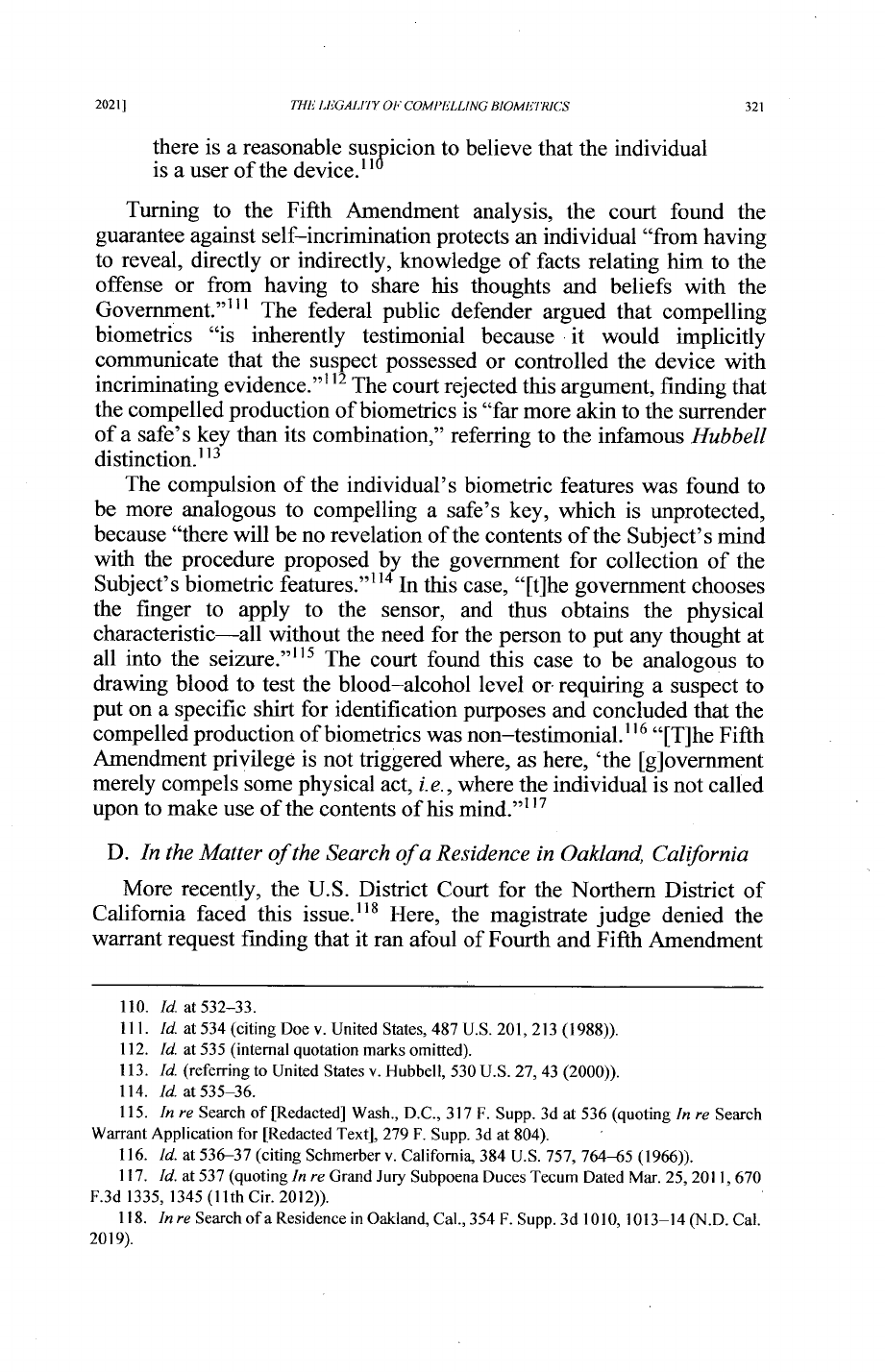
TH
LEGALFIY
OF
COMP'ELLING
BIOMETRICS
there
is
a
reasonable
suspicion
to
believe
that
the
individual
is
a
user
of
the
device.
10
Turning
to
the
Fifth
Amendment
analysis,
the
court
found
the
guarantee
against
self-incrimination
protects
an
individual
"from
having
to
reveal,
directly
or
indirectly,
knowledge
of
facts
relating
him
to
the
offense
or
from
having
to
share
his
thoughts
and
beliefs
with
the
Government."
1
"
The
federal
public
defender
argued
that
compelling
biometrics
"is
inherently
testimonial
because
it
would
implicitly
communicate
that
the
suspect
possessed
or
controlled
the
device
with
incriminating
evidence."
1 2
The
court
rejected
this
argument,
finding
that
the
compelled
production
of
biometrics
is
"far
more
akin
to
the
surrender
of
a
safe's
key
than
its
combination,"
referring
to
the
infamous
Hubbell
distinction.
13
The
compulsion
of
the
individual's
biometric
features
was
found
to
be
more
analogous
to
compelling
a
safe's
key,
which
is
unprotected,
because
"there
will
be
no
revelation
of
the
contents
of
the
Subject's
mind
with
the
procedure
proposed
by
the
government
for
collection
of
the
Subject's
biometric
features.""
4
In
this
case,
"[t]he
government
chooses
the
finger
to
apply
to
the sensor,
and
thus
obtains
the
physical
characteristic-all
without
the
need
for
the
person
to
put
any
thought
at
all
into
the
seizure."
1 5
The
court
found
this
case
to
be
analogous
to
drawing
blood
to
test
the
blood-alcohol
level
or-
requiring
a
suspect
to
put
on
a
specific
shirt
for
identification
purposes
and
concluded
that
the
compelled
production
of
biometrics
was
non-testimonial."1
6
"[T]he
Fifth
Amendment
privilege
is
not
triggered
where,
as
here,
'the
[g]overnment
merely
compels
some
physical
act,
i.e.,
where
the
individual
is
not called
upon
to
make
use
of
the
contents
of
his
mind.""'
D.
In
the
Matter
of
the
Search
of
a
Residence
in
Oakland,
California
More
recently,
the
U.S.
District
Court
for
the
Northern
District
of
California
faced
this
issue.
1 18
Here,
the
magistrate
judge
denied
the
warrant
request
finding
that
it
ran afoul
of
Fourth
and
Fifth
Amendment
110. Id.
at
532-33.
111.
Id.
at
534
(citing
Doe
v.
United
States,
487
U.S.
201,
213
(1988)).
112.
Id
at
535
(internal
quotation
marks
omitted).
113.
Id
(referring
to United
States
v.
Hubbell,
530
U.S.
27,
43
(2000)).
114.
Id.
at
535-36.
115.
In
re
Search
of
[Redacted]
Wash.,
D.C.,
317
F.
Supp.
3d
at
536
(quoting
In
re
Search
Warrant
Application
for [Redacted
Text],
279
F.
Supp.
3d
at
804).
116.
Id.
at
536-37
(citing
Schmerber
v.
California,
384
U.S.
757,
764-65
(1966)).
117.
Id.
at
537
(quoting
In
re
Grand
Jury
Subpoena
Duces
Tecum
Dated
Mar.
25,
2011,
670
F.3d
1335,
1345
(11th
Cir.
2012)).
118.
In
re
Search
of
a
Residence
in
Oakland,
Cal.,
354
F.
Supp.
3d
1010,
1013-14
(N.D.
Cal.
2019).
20211l
321
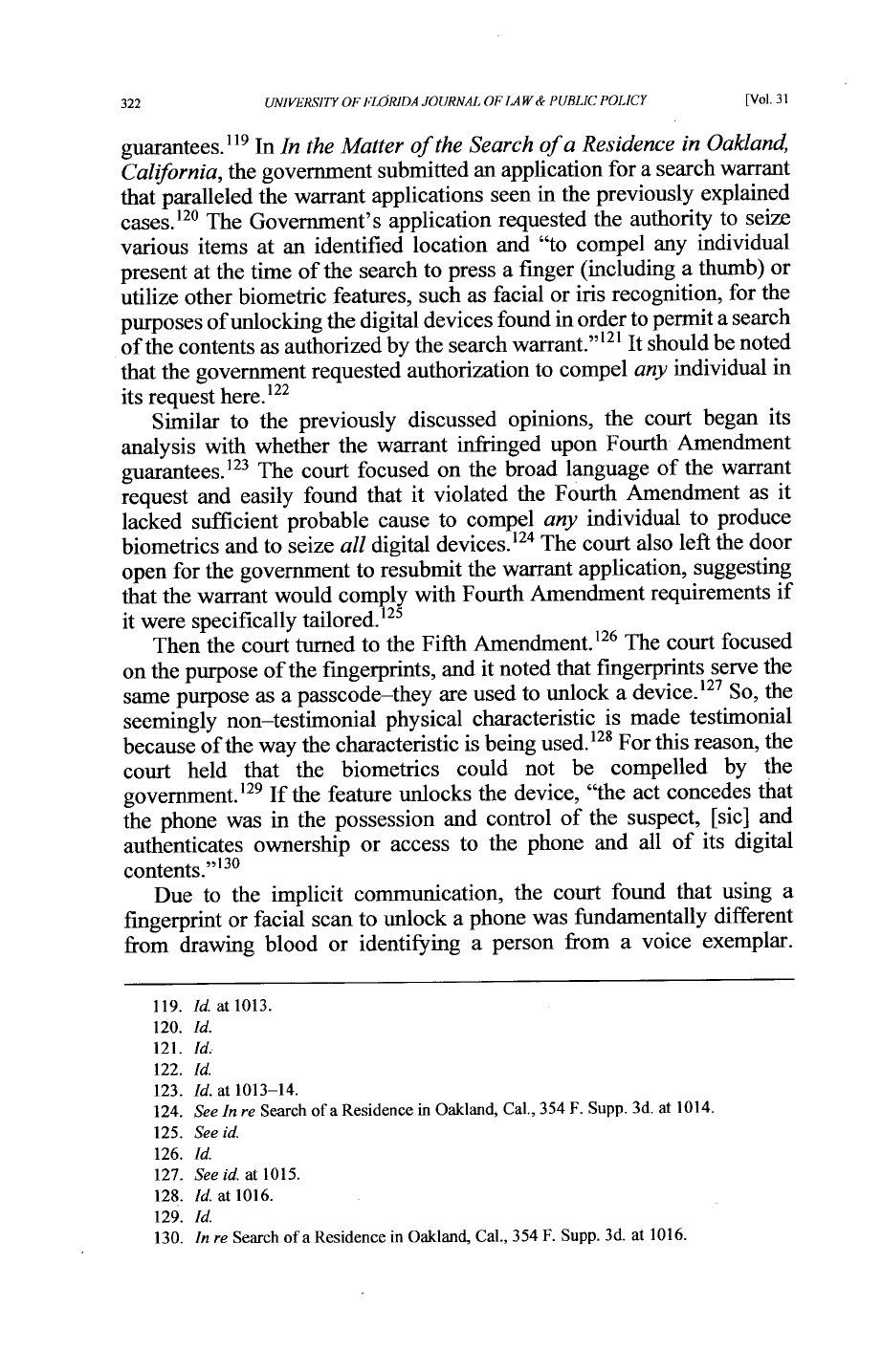
UNIVERSITY
OF
FLORIDA
JOURNAL
OF
IA
W&
PUBLIC
POLICY
guarantees.
11
9
In
In
the
Matter
of
the
Search
of
a
Residence
in
Oakland,
California,
the
government
submitted
an
application
for
a
search
warrant
that
paralleled
the
warrant
applications
seen
in
the
previously
explained
cases.
12
0
The
Government's
application
requested
the
authority
to
seize
various
items
at
an
identified
location
and
"to
compel
any
individual
present
at
the
time
of
the
search
to
press
a
finger
(including
a
thumb)
or
utilize
other
biometric
features,
such
as
facial
or
iris
recognition,
for
the
purposes
of
unlocking
the
digital
devices
found
in
order
to
permit
a search
of
the
contents
as
authorized
by
the
search
warrant."
12
1
It
should
be
noted
that
the
government
requested
authorization
to
compel
any
individual
in
its
request
here.
12
2
Similar
to
the
previously
discussed
opinions,
the
court
began
its
analysis
with
whether
the
warrant
infringed
upon
Fourth
Amendment
guarantees.1
2
3
The
court
focused
on
the
broad
language
of
the
warrant
request
and
easily
found
that
it
violated
the
Fourth
Amendment
as
it
lacked
sufficient
probable
cause
to
compel
any
individual
to
produce
biometrics
and
to
seize
all
digital
devices.
12
4
The
court
also
left
the
door
open
for
the
government
to
resubmit
the
warrant
application,
suggesting
that
the
warrant
would
comply
with
Fourth
Amendment
requirements
if
it
were
specifically
tailored.
25
Then
the
court
turned
to
the
Fifth
Amendment.1
26
The
court
focused
on
the
purpose
of
the
fingerprints,
and
it
noted
that
fingerprints
serve
the
same
purpose
as
a
passcode-they
are
used
to
unlock
a
device.1
2 7
So,
the
seemingly
non-testimonial
physical
characteristic
is
made
testimonial
because
of
the
way
the
characteristic
is
being
used.
12 8
For
this
reason,
the
court
held
that
the
biometrics
could
not
be
compelled
by
the
government.1
29
If
the
feature
unlocks
the
device,
"the
act
concedes
that
the
phone
was
in
the
possession
and
control
of
the
suspect,
[sic]
and
authenticates
ownership
or
access
to
the
phone
and
all
of
its
digital
contents."'30
Due
to
the
implicit
communication,
the
court
found
that
using
a
fingerprint
or
facial
scan
to
unlock
a
phone
was
fundamentally
different
from
drawing
blood
or
identifying
a
person
from
a
voice
exemplar.
119.
Id.
at
1013.
120.
Id.
121.
Id.
122.
Id.
123.
Id.
at
1013-14.
124.
See
In re
Search
of
a
Residence
in
Oakland,
Cal.,
354
F.
Supp.
3d.
at
1014.
125.
See
id.
126.
Id.
127.
See
id.
at
1015.
128.
Id.
at 1016.
129.
Id.
130.
In
re
Search
of
a
Residence
in
Oakland,
Cal.,
354
F.
Supp.
3d.
at
1016.
[Vol.
31
322
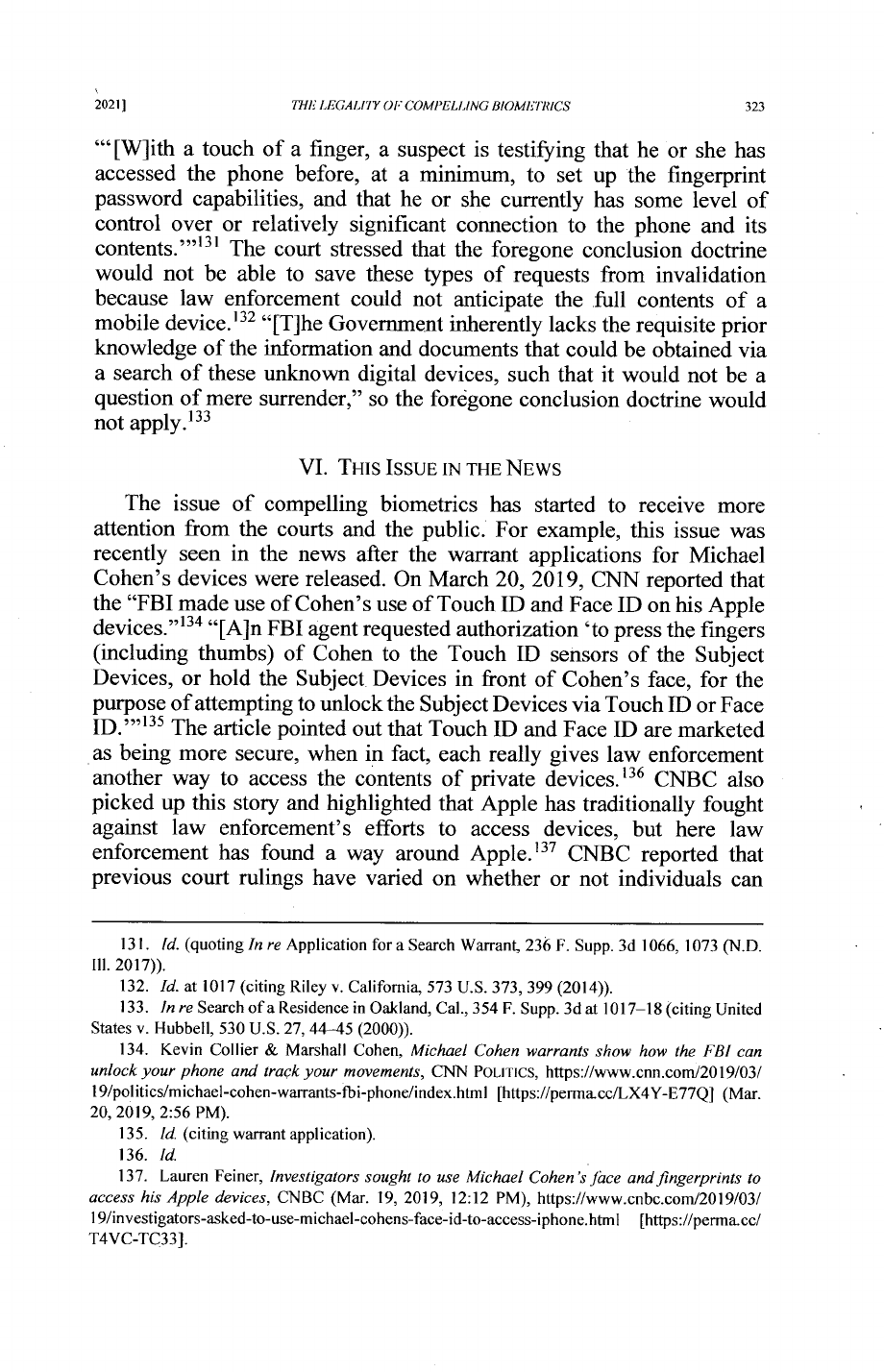
20211
THE
LEGALITY
OF
COMPELLING
BIOMETRICS
323
"'[W]ith
a
touch
of
a
finger,
a
suspect
is
testifying
that
he
or
she
has
accessed
the
phone
before,
at
a
minimum,
to
set
up
the
fingerprint
password
capabilities,
and
that
he
or
she
currently
has
some
level
of
control
over
or
relatively
significant
connection
to
the
phone
and
its
contents.'""
3
'
The
court
stressed
that
the
foregone
conclusion
doctrine
would
not
be
able
to save
these
types
of
requests
from
invalidation
because
law
enforcement
could
not
anticipate
the
full
contents
of
a
mobile
device.'
3 2
"[T]he
Government
inherently
lacks
the
requisite
prior
knowledge
of
the
information
and
documents
that
could
be
obtained
via
a
search
of
these
unknown
digital
devices,
such
that
it
would
not
be
a
question
of
mere
surrender,"
so
the
foregone
conclusion
doctrine
would
not
apply.
1 33
VI.
THIS
ISSUE
IN
THE
NEWS
The
issue
of
compelling
biometrics
has
started
to
receive
more
attention
from
the
courts
and
the
public.
For
example,
this
issue
was
recently
seen
in
the news
after
the
warrant
applications
for
Michael
Cohen's
devices
were
released.
On
March
20,
2019,
CNN
reported
that
the
"FBI
made
use
of
Cohen's
use
of
Touch
ID
and
Face
ID
on
his
Apple
devices."
1
3 4
"[A]n
FBI
agent
requested
authorization
'to
press
the
fingers
(including
thumbs)
of
Cohen
to
the
Touch
ID
sensors
of
the
Subject
Devices,
or
hold
the
Subject
Devices
in
front
of
Cohen's
face,
for
the
purpose
of
attempting
to
unlock
the
Subject
Devices
via
Touch
ID
or
Face
ID.""
5
The
article
pointed
out
that
Touch
ID
and
Face
ID
are
marketed
as
being
more
secure,
when
in
fact,
each
really
gives
law
enforcement
another
way
to
access
the
contents
of
private
devices.1
36
CNBC
also
picked
up
this
story
and
highlighted
that
Apple
has
traditionally
fought
against
law
enforcement's
efforts
to
access
devices,
but
here
law
enforcement
has
found
a
way
around
Apple.
13
7
CNBC
reported
that
previous
court
rulings
have
varied
on whether
or
not
individuals
can
131.
Id.
(quoting
In
re
Application
for
a Search
Warrant,
236
F.
Supp.
3d
1066,
1073
(N.D.
QIl.
2017)).
132.
Id.
at
1017
(citing
Riley
v.
California,
573
U.S. 373,
399
(2014)).
133.
In
re
Search
of
a
Residence
in
Oakland,
Cal.,
354
F.
Supp.
3d
at
1017-18
(citing
United
States
v.
Hubbell,
530 U.S.
27,
44-45
(2000)).
134.
Kevin
Collier
&
Marshall
Cohen,
Michael
Cohen
warrants
show
how
the
FBI
can
unlock
your
phone
and
track
your
movements,
CNN
POLITICs,
https://www.cnn.com/2019/03/
19/politics/michael-cohen-warrants-fbi-phone/index.html
[https://perma.cc/LX4Y-E77Q]
(Mar.
20,
2019,
2:56
PM).
135.
Id.
(citing
warrant
application).
136.
Id.
137.
Lauren
Feiner,
Investigators
sought
to
use
Michael
Cohen's
face
and fingerprints
to
access
his
Apple
devices,
CNBC
(Mar.
19,
2019,
12:12
PM),
https://www.cnbc.com/2019/03/
19/investigators-asked-to-use-michael-cohens-face-id-to-access-iphone.html
[https://perma.cc/
T4VC-TC33].

UNIVERSITY
OF
FLORIDA
JOURNAL
OF
LAW
&
PUBLIC
POLICY
legally
be
compelled
to
produce
biometric
data
so
that
law
enforcement
officials
can
gain
access
to their
electronic
devices.1
38
VII.
IS
THE
SOLUTION
TO
REQUIRE
A
PASSCODE?
A
passcode
is
made
up
of
a
sequence
of
letters,
numbers,
and
other
characters.
A
passcode
can
be
required
prior
to
accessing
an
electronic
device.
Just
like
biometric
recognition
in
cell
phones,
passcodes
are
a
way
to
protect
a
device
from
unwanted
intrusion.
Although
biometrics
and
passcodes
serve
the
same
purpose,
passcodes
are
treated
differently
under
the
law.
Courts
have
afforded
more
protections
to
passcodes
finding
that
passcodes,
as
opposed
to
biometrics,
are
protected
under
the
Fifth
Amendment
as
testimonial
communications.!
9
While
there
are
some
exceptions,
most
courts
have
ruled
that
an
individual
cannot
be
forced
to
reveal
their
passcode,
as
this
requires
an
individual
to reveal
the
inner
contents
of
their
mind.1
40
In
the
2014
decision
of
Commonwealth
of
Virginia
v.
Baust,141
the
state
court
held
that
the
defendant's
passcode
could
not
be
compelled
because
of
the
Fifth
Amendment
right
against
self-incrimination.'
In
the
same
breath,
the
court
held
that
the
defendant
could
be
forced
to
produce
his
fmgerprint.1
43
The
court
reasoned
that
compelling
a
passcode
required
the
defendant
to
reveal
his
mental
processes,
which
is
testimonial,
but
compelling
fmgerprints
would
not
require
the
defendant
to
communicate
anything
so
it
did
not
qualify
as
a
protected
communication
under
the
Fifth
Amendment.
44
Despite
the
fact
that
passcodes
and
fmgerprints
are
being
used
for
the
same
purpose
here,
courts
have
tended
to
distinguish
the
two.
In
light
of
this,
requiring
a
passcode
appears
to
be
the
most
secure
method
of
protecting
electronic
devices.
CONCLUSION
The
question
of
whether
law
enforcement
can
compel
an
individual
to
produce
fingerprints
and
other
biometrics
for
the
purpose
of
unlocking
a
lawfully
seized
electronic
is
an
important
one
due
to
the
pervasive
presence
of
cellphones
and
the
amount
of
data
contained
within
a
device.
138.
Id.
139.
See
Pratik
Parikh,
IPHONE
X:
Unlocking
the
Self
Incrimination
Clause
of
the
Fifth
Amendment,
45
RUTGERS
COMPUTER
&
TECH.
L.J.
58,
78
(2019)
(citing
United
States
v.
Kirschner,
823
F.
Supp.
2d
665,
668
(E.D.
Mich.
2010)).
140.
Commonwealth
v.
Baust,
89
Va.
Cir.
267,
270
(Va.
Cir.
Ct.
2014)
(citing
United
States
v.
Doe,
487
U.S.
201,
211
(1988));
but
see
State
v.
Stahl,
206
So.
3d
124,
137
(Fla.
Dist.
Ct.
App.
2016)
(holding
that
requiring
the
defendant
to
produce
his
passcode
was
not
testimonial).
141.
89
Va.
Cir.
267
(Va.
Cir.
Ct.
2014).
142.
Id.
at
271.
143.
Id.
144.
Id.
[Vol.
31
324
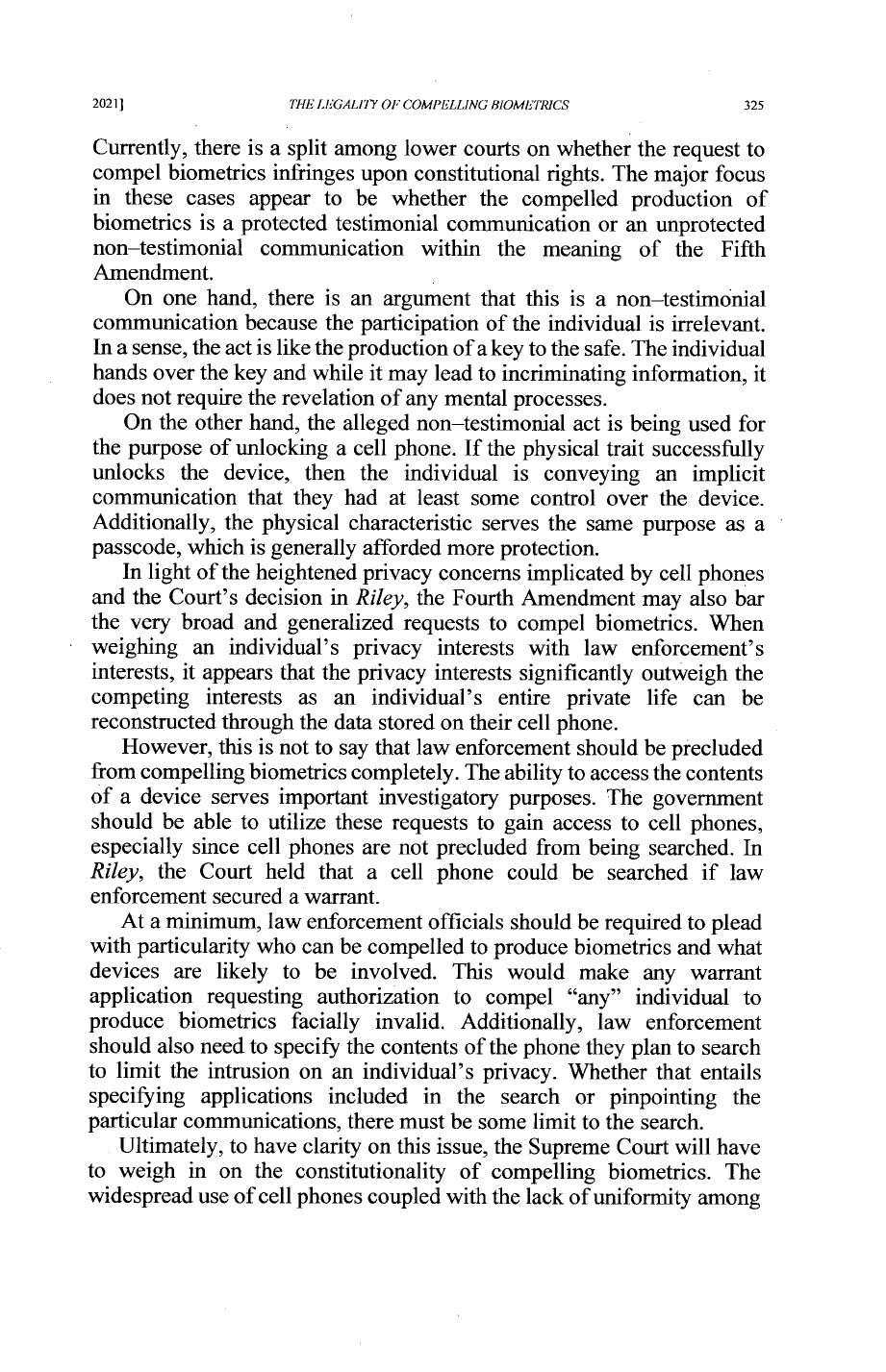
THE
L
EGAL1TY
OF
COMPELLING
BIOMETRICS
Currently,
there
is
a
split
among
lower
courts
on
whether
the
request
to
compel
biometrics
infringes
upon
constitutional
rights.
The
major
focus
in
these
cases
appear
to
be
whether
the
compelled
production
of
biometrics
is
a
protected
testimonial
communication
or
an
unprotected
non-testimonial
communication
within
the
meaning
of
the
Fifth
Amendment.
On
one
hand,
there
is an
argument
that
this
is
a
non-testimonial
communication
because
the
participation
of
the
individual
is
irrelevant.
In
a
sense,
the
act
is
like
the
production
of
a
key
to
the
safe.
The
individual
hands
over
the
key
and
while
it may
lead
to
incriminating
information,
it
does
not
require
the
revelation
of
any
mental
processes.
On
the
other
hand,
the
alleged
non-testimonial
act
is
being
used
for
the
purpose
of
unlocking
a
cell
phone.
If
the
physical
trait
successfully
unlocks
the
device,
then
the
individual
is
conveying
an
implicit
communication
that
they
had
at
least
some
control
over
the
device.
Additionally,
the
physical
characteristic
serves
the
same
purpose
as
a
passcode,
which
is
generally
afforded
more
protection.
In
light
of
the
heightened
privacy
concerns
implicated
by
cell
phones
and the
Court's
decision
in
Riley,
the
Fourth
Amendment
may
also
bar
the
very
broad
and
generalized
requests
to
compel
biometrics.
When
weighing
an
individual's
privacy
interests
with
law
enforcement's
interests,
it
appears
that
the
privacy
interests
significantly
outweigh
the
competing
interests
as
an
individual's
entire
private
life
can
be
reconstructed
through
the
data
stored
on
their
cell
phone.
However,
this
is
not
to
say
that
law
enforcement
should
be
precluded
from
compelling
biometrics
completely.
The
ability
to
access
the
contents
of
a
device
serves
important
investigatory
purposes.
The
government
should
be
able
to
utilize
these
requests
to
gain
access
to
cell
phones,
especially
since
cell
phones
are
not
precluded
from
being
searched.
In
Riley,
the
Court
held
that
a
cell
phone
could
be
searched
if
law
enforcement
secured
a
warrant.
At
a
minimum,
law
enforcement
officials
should
be
required
to
plead
with
particularity
who
can
be
compelled
to
produce
biometrics
and
what
devices
are
likely
to
be
involved.
This
would
make
any
warrant
application
requesting
authorization
to compel
"any"
individual
to
produce
biometrics
facially
invalid.
Additionally,
law
enforcement
should
also
need
to specify
the
contents
of
the
phone
they
plan
to
search
to
limit
the
intrusion
on
an
individual's
privacy.
Whether
that
entails
specifying
applications
included
in
the
search
or
pinpointing
the
particular
communications,
there
must
be
some
limit
to
the
search.
Ultimately,
to
have
clarity
on
this
issue,
the
Supreme
Court
will
have
to
weigh
in on
the
constitutionality
of
compelling
biometrics.
The
widespread
use
of
cell
phones
coupled
with
the
lack
of
uniformity
among
2021]
325
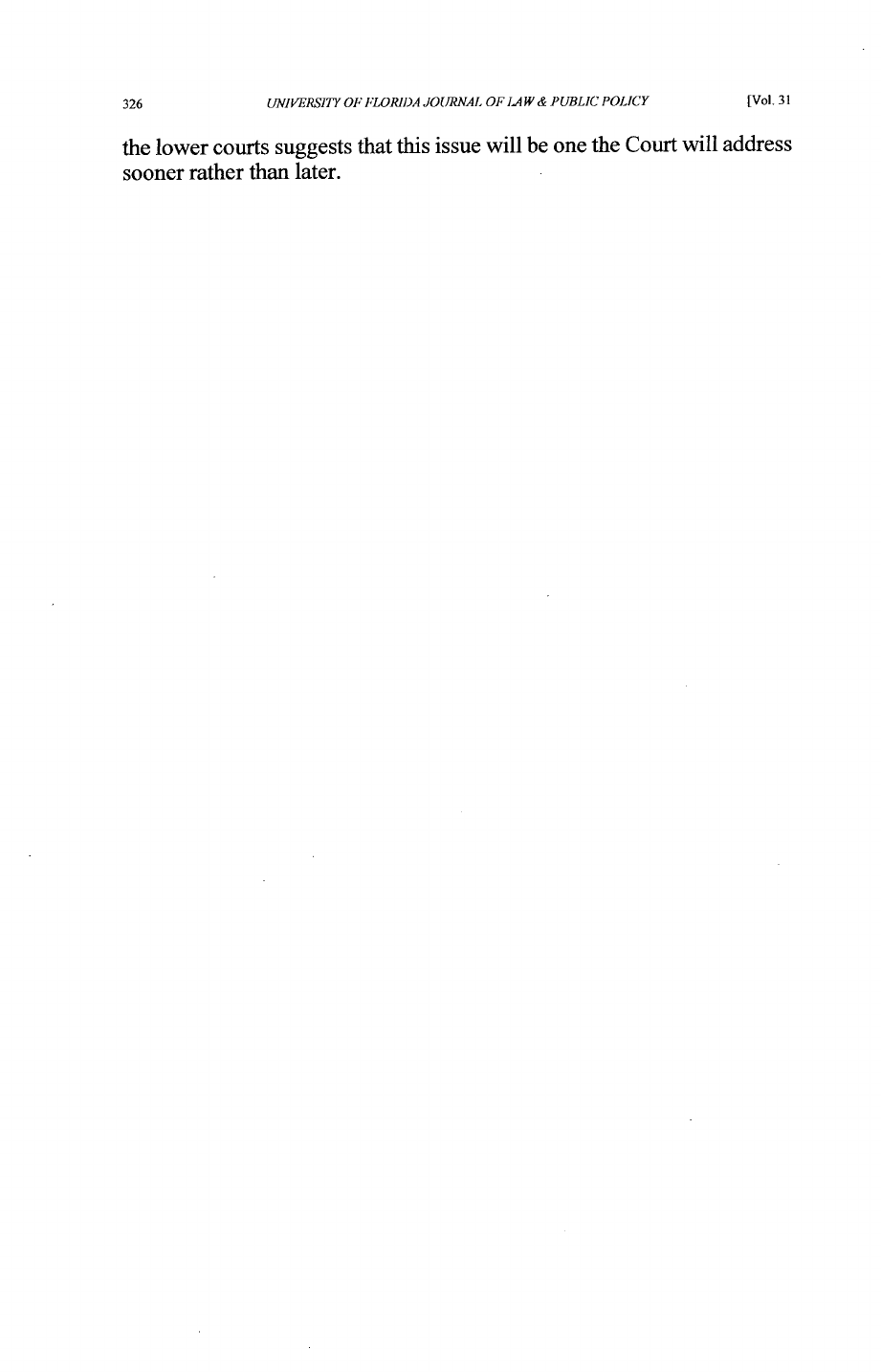
326
UNIVERSITY
OF
FLORIDA
JOURNAL
OF
LAW
&
PUBLIC
POLICY
[Vol.
31
the
lower
courts
suggests
that
this
issue
will
be
one
the
Court
will
address
sooner
rather
than
later.
